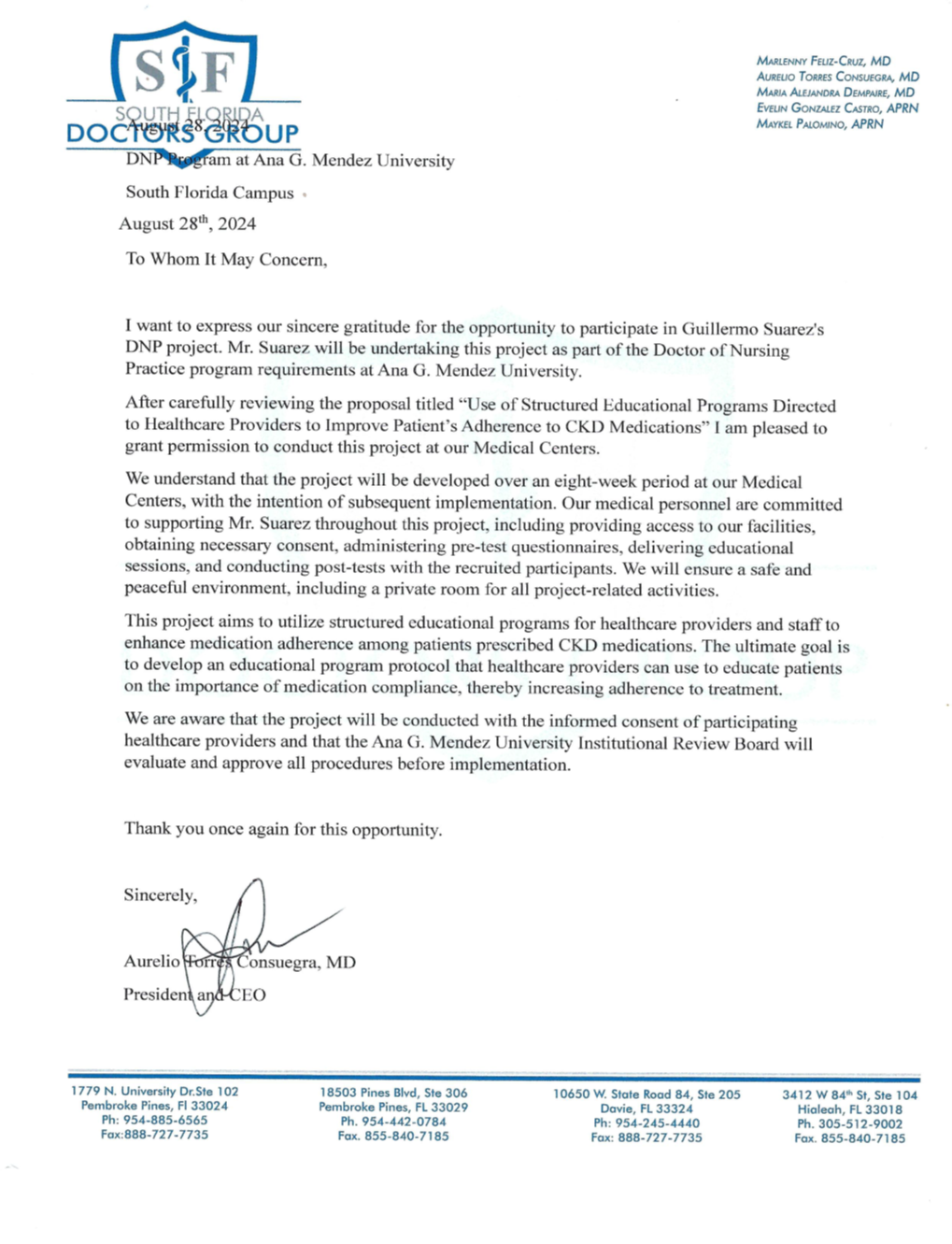Use of Structured Educational Programs Directed to Healthcare Providers to Improve Patients' Adherence to CKD Medications.
Submitted by Guillermo Suarez, MSN, APRN-BC
Tags: Kidney Disease Nurse Education public health

Acknowledgements
I would like to express my heartfelt gratitude to the faculty and staff at Ana G. Mendez University for their unwavering support, encouragement, and academic guidance throughout this doctoral journey. A special thank you to Dr. Geisy M. Vilabrille, whose mentorship, patience, and commitment were instrumental in the development and completion of this DNP project.
I am deeply thankful to South Florida Doctors Group and its dedicated team for allowing me to implement my project in their clinical setting. Your openness to educational advancement and commitment to quality care created the ideal environment for this initiative to succeed.
To my loving family, thank you. To my wife, son, and daughter: your encouragement, sacrifices, and belief in me gave me the strength to persevere during challenging times. Your love has been the foundation of my resilience.
Finally, I extend my appreciation to my dear friends and colleagues, whose support, camaraderie, and shared experiences have made this journey not only possible but meaningful. I am truly grateful to each of you.
Dedication
This project is lovingly dedicated to my family, whose unwavering support has been the foundation of my journey. To my wife and children, your love, patience, and encouragement have carried me through every challenge. You are my greatest joy, my inspiration, and the reason I strive to become better each day.
To my parents, who instilled in me the value of hard work, resilience, and compassion, thank you for your sacrifices and the example you set. To my colleagues and mentors, thank you for your encouragement and collaboration throughout this transformative experience.
This project is especially dedicated to all those, like me, who embarked on a new path later in life, proving that growth, learning, and passion have no expiration date. May this serve as a reminder that it's never too late to chase your dreams, elevate your purpose, and redefine your impact.
Abstract
Chronic Kidney Disease (CKD) presents a significant public health challenge due to its progressive nature, associated comorbidities, and increasing prevalence in the United States. One of the critical barriers to effective CKD management is poor patient adherence to prescribed medication regimens. This Doctor of Nursing Practice (DNP) project aimed to assess the effectiveness of a structured educational program for healthcare providers in a South Florida medical center to improve medication adherence among CKD patients. Guided by Patricia Benner’s Novice to Expert Theory, the project utilized a pre-posttest quasi-experimental design to evaluate changes in provider knowledge and perceived confidence in managing medication adherence.
The intervention included an evidence-based educational PowerPoint presentation targeting healthcare professionals—physicians, nurse practitioners, physician assistants, nurses, and medical assistants—who care for CKD patients. Participants (n = 21) completed a pretest to assess baseline knowledge, attended the educational session, and completed a posttest to evaluate improvements. Data analysis showed a marked increase in posttest scores and self-reported confidence, with 81% of participants demonstrating enhanced understanding of CKD medication adherence strategies.
Results support the efficacy of provider-directed educational programs in promoting adherence behaviors in CKD patients through improved communication, individualized care planning, and consistent follow-up. The project underscores the importance of providing education in addressing non-adherence medication and serves as a scalable model for other chronic disease management initiatives. Findings were disseminated to institutional stakeholders and prepared for publication to encourage broader implementation.
Keywords: Chronic Kidney Disease, medication adherence, healthcare providers, educational intervention, DNP project, Patricia Benner, structured education, patient outcomes.
Table of Contents`
Acknowledgements ……………………………………………………………….. 2
Dedication …………………………………………………………………………. 3
Abstract ……………………………………………………………………………. 4
List of Tables and Graphs …………………………………………………………. 8
CHAPTER 1: The Problem ……………………………………………………………… 9
Problem Background ……………………………………………………………………. 9
Significance of the Problem …………………………………………………………….. 10
Purpose of the Study and Objectives …………………………………………………….. 14
Research Question- PICOT……………………………………………………………….. 15
CHAPTER 2: Review of the Literature ………………………………………………….. 16
Theoretical Framework …………………………………………………………………... 16
Synthesis of the Literature ………………………………………………………………... 21
Summary …………………………………………………………………………………. 38
CHAPTER 3: Methodology ………………………………………………………………. 39
Research Design ………………………………………………………………………….. 39
Sample ……………………………………………………………………………………. 39
Inclusion Criteria …………………………………………………………………………. 39
Risk, Protection of Privacy, Confidentiality, and Decommission Process …....…...…….. 40
Potential Benefits and Incentives …………………………………………………………. 40
Tool………………………………………………………………………………………... 41
Vision, Mission, and Objectives ……………………………………....………………….. 41
Setting and Data Collection Method………….…………………………………………… 42
Interventional Phase and Educational Program of the Study...……....................................... 43
Data Analysis……………………………………………………………………………… 44
Ethical Considerations…………………………………………………………………….. 44
Implications of the Study………………………………………………………………….. 44
Plan for Dissemination, Presentation, and Publication……………………………………. 45
Conclusion…………………………………………………………………………...…….. 49
Results and Discussion ………………………………………………………………………. 49
Analysis of Frequency Table………………………………………………………………… 50
Crosstab Analysis Table …………………………………………………………………….. 51
References …………………………………………………………………………………… 82
Appendix………………………………………………………………………………..…….. 92
Appendix 1 Informed Consent ……………………………………………………………….. 93
Appendix 2 Pre-test and Post-test ..…………………………………………………………... 95
Appendix 3 Support Letter from Clinical Site ……………………………………………….. 99
LIST OF TABLES AND GRAPHS
Tables
Frequency Table …………………………………………………………………….. 52
Gender Table ………………………………………………………………………... 52
Age Table …………………………………………………………………………… 52
Professional Designation Table …………………………………………………….. 52
Time in the Field Table …………………………………………………………….. 53
Pre and Post Test Questions Tables ………………………………………………… 53
Crosstab Tables ……………………………………………………………………... 57
Graphs
Graphs ……………………………………………………………………………… 67
Use of Structured Educational Programs Directed to Healthcare Providers to Improve Patients’ Adherence to CKD Medications
CHAPTER I: THE PROBLEM
Problem Background
Chronic Kidney Disease (CKD) is a serious, progressive healthcare condition that has adversely affected millions around the world. Characterized by the gradual loss of kidney function, CKD patients were around 35.5 million in the United States in 2023 (CDC, 2024; Charles and Ferris, 2020). The data on CKD also reveals that around 1.9 million individuals died in the United States in 2019, either directly or indirectly, because of the chronic healthcare condition. Furthermore, the probability of medical complications, such as comorbidities, is quite high in CKD cases. One of the factors strongly affecting CKD’s effective management is adherence to CKD medication. Halle et al. (2020) have found that medication adherence in CKD cases correlates directly and strongly with desired clinical outcomes, including lower probability of CKD complications, fewer hospital visits, and improved quality of life. Despite the obvious, positive, and credible association between medication adherence and desired clinical outcomes, medication adherence is not ideal among CKD patients. Therefore, the probability that CKD cases will aggravate is alarmingly high, which is evident from the data related to CKD fatalities ( Anderson et al, 2021).
The scholarly literature suggests that educational programs for clinicians centered around medication adherence can resolve the issue. However, these educational programs should be evidence-based and structured. Therefore, the purpose of the practice change project is to use structured educational programs directed at healthcare providers to improve patients’ adherence to CKD medications (Note: The term structured in structured educational intervention implies that the devised intervention is implemented methodically and through a process).
Significance of the Problem
Medication adherence is an intricate procedure involving healthcare providers and patients. Numerous factors related to non-adherence to chronic kidney disease medications may result in discontinuation. The socioeconomic status, health literacy, beliefs, and self-care characteristics held by patients may trigger the discontinuation of medical regimens for the patients (Seng et al., 2020). In addition, intricate prescription administrations, unsuitable follow-up, insufficient relationships between patients and providers, improper communication, and inadequate patient-oriented care inhibit the process of medication adherence among patients.
Patient compliance with the set treatment programs is the interface between efficient therapy and the management of chronic kidney disease. Moreover, adherence may be impacted by the association between the patients and the health practitioner, along with their attitude toward one another. In addition, healthcare providers’ and staff conduct may affect the health status and behavior of the patient, influencing their adherence (Kvarnström et al., 2021). Social factors, such as marital status, socioeconomic status, and age status, as well as the education level of participants, play a substantial role in medication adherence.
Distinct approaches to evaluate medication adherence comprise electronic drug monitors, self-reports, and pharmacy claims for refills. In some instances, there are various noble indicators of medication adherence among chronic kidney patients. Nevertheless, a prevalent concern is the need for more standard tools for measuring non-adherence and more reliable interventions (Halle et al., 2020). Numerous strategies have been suggested to elevate patient medication adherence. For example, improving the relationships between patients and providers, establishing guidelines or protocols for follow-up, creating clinical pathways to confirm suitable decision-making, reinforcing healthcare delivery, ensuring sufficient follow-up, technology application, and simplifying medical treatment. Even in cases where distinct interventions have been adopted, only intricate interventions that involve active engagement of healthcare providers and close follow-up with patients showcase substantial progress. Furthermore, whenever there are shared motivations between patients and healthcare providers, medication adherence is substantially increased among patients.
Reduced medication adherence results in substantial financial and healthcare costs. Since behavioral aspects partially steer minimal medication adherence, there is a potential for efficient interventions for enhancing medication adherence and improving health outcomes. It calls for effective interventions to enhance medication adherence based on an analysis of systematic evidence. Educational initiatives for healthcare providers have significantly improved medication adherence (Mannan et al., 2021). All healthcare providers must get adequate training in risk factors associated with non-adherence, the effects of non-adherence, and approaches to enhancing adherence.
Continuous training of healthcare providers on risk evaluation and desirable behavioral communication helps support such efforts. Additionally, medical practitioners are essential in involving patients through their exclusive perceptions and lived treatment experiences, constituting issues associated with medication adherence and decisions (Seng et al., 2020). They are involved in orienting, welcoming, and offering information to patients regarding their treatment location, rights, and expectations, tackling issues concerning treatment, such as issues associated with medication and other duties. Healthcare providers are critical in assessing, managing, and treating chronic kidney disease. Effective communication between patients and healthcare professionals significantly impacts patients' adherence to distinct medication treatments, particularly when managing chronic kidney diseases (Kvarnström et al., 2021). The possibility of inadequate medication adherence is significantly higher whenever there is insufficient communication between healthcare providers and patients regarding medication, patient preferences, and the patient's psychosocial characteristics.
Communication between patients and healthcare providers is a critical factor behind the increase in patients not adhering to treatment regimens. Inadequate communication causes a lack of comprehension among patients regarding the merits of medication use, which becomes a critical facet in patients discontinuing treatment (Kvarnström et al., 2021). Intervention at the health systems, providers, and patient levels positively affects chronic kidney disease management. Therefore, medication adherence is crucial when considering chronic kidney disease patients.
Various research studies conclude that healthcare providers must evaluate adherence during their encounters, and inadequate communication between providers and patients is an undesirable factor in medication adherence. Even so, more consensus on the different ways of tackling non-adherence and the lack of clinical protocol could impact the efficiency of healthcare providers (Seng et al., 2020). Certain studies propose distinct approaches to addressing this subject. In some instances, educational techniques have been fruitful. In addition, other research studies offer recommendations to enhance communication between providers and patients, addressing the needs of both patients and healthcare practitioners. Nevertheless, no single algorithm can help healthcare professionals discuss subjects relating to non-adherence to medication among patients.
However, cooperation between healthcare providers and patients to achieve a common objective is more efficient than personal initiatives. Healthcare providers play a significant role in modeling beliefs and attitudes among patients concerning medication adherence and the management of chronic kidney disease. Inadequate focus by healthcare providers on issues regarding medication adherence during prescription and their take on managing non-adherence and chronic kidney disease treatments are known to affect patients' medication adherence negatively. Previous systematic reviews demonstrate that quality enhancement projects may effectively manage chronic kidney disease and enhance medication adherence in chronic kidney disease patients (Tesfaye et al., 2024). Shifts in the relationship between healthcare providers and patients comprise adhering to the guidelines or formulating clinical pathways, ensuring suitable decision-making, intensifying healthcare delivery, technology use, medical treatment simplification, and accurate follow-up.
Chronic kidney disease patients are urged to cope with complex treatment options and interventions consisting of medications that last throughout their medical treatment sessions. Therefore, patients must adhere to and follow the set medication treatment to maintain optimum well-being and health. It is significant for healthcare providers to take their time regularly to comprehend the factors hindering an individual patient from observing treatment alternatives (Rivera et al., 2022). The medical practitioner who understands the patient well can formulate individualized interventions to minimize the challenges interfering with the patient's capacity to observe the treatment options. Healthcare providers’ education is a critical part of improving healthcare delivery. Knowledge is significant for healthcare providers to address the challenges of medication adherence faced by chronic kidney disease patients.
Issues affecting medication adherence are numerous within the healthcare setting. Intervention by healthcare providers can ensure patients adhere to medications to help reduce chronic kidney disease. Medical practitioners are better positioned to deliver suitable education to elevate patients' medication adherence and enhance medical outcomes (Kvarnström et al., 2021). Informative and educational interventions targeting healthcare providers to help increase medical adherence for chronic kidney disease patients are significant. Simplifying medication treatment and proper communication between healthcare providers and patients may help achieve better outcomes.
Structured educational programs to increase healthcare providers' awareness of clinical protocols regarding medication adherence for chronic kidney disease patients are critical in improving adherence. Such programs result in a shift in the practitioners' attitudes, positively influencing patients' conduct, thus an escalation in medication adherence (Tesfaye et al., 2021). Such a change in the attitude of providers has desirable impacts on the behavior of patients since the involvement of practitioners leads to an improvement in prescription activity. Hence, more patients are monitored and educated. Adopting a structured education program for healthcare providers emphasizes measuring care quality by increasing patients' medication adherence to chronic kidney disease medications.
Purpose of the Study and Objectives
This study aims to assess the impact of a structured educational program directed to healthcare providers to improve patient adherence to CKD medications in a South Florida Medical Center.
Objectives
- To plan, implement, and assess the structured educational program’s efficacy
- To evaluate the level of proficiency of healthcare providers in enhancing medical adherence among patients with chronic kidney disease before and after adopting a structured educational program.
PICOT Question
The PICOT question guiding this project is:
"In healthcare providers caring for patients with Chronic Kidney Disease (P), how does a structured educational program (I), compared to pre-test baseline knowledge (C), impact post-test knowledge scores and patient adherence to CKD medications (O) over 8 weeks (T)?"
- Population- healthcare providers
- Intervention- structured educational programs
- Comparison- Compared to pre-test baseline knowledge,
- Outcomes- impact post-test knowledge scores and patient adherence to CKD medications,
- Time- 8 weeks
CHAPTER II: REVIEW OF LITERATURE
Theoretical Framework
Nursing models and theories add to the establishment of the nursing profession by backing autonomous nursing roles during the delivery of care based on nursing processes. Nursing staff in medical and health facilities can use their positions of power to enhance care quality and patient outcomes by employing nursing models to guide them in their daily practices. Such models and concepts offer an apparatus for a systematic approach to teaching clinical and theoretical knowledge. The "Novice to Expert" nursing theory by Patricia Benner is a renowned and valuable conceptual framework guiding nurses’ professional development (Oshvandi et al., 2016). This paper elaborates on the guidance Benner's concept offers nurses and healthcare providers in their practice across their clinical experience.
Doctor Patricia Benner graduated from Pasadena College with a bachelor’s degree in arts in 1964. Benner has a master’s degree in medical-surgical nursing from the University of California, which she earned in 1970. Benner also graduated with a Doctor of Philosophy in the same field and institution. Furthermore, she operated as a head nurse at the Kansas City General Hospital's Coronary Care Unit. Furthermore, Benner also served as a nurse staff member at the Stanford University Hospital and Medical Center's intensive care facility (Benner, 2021). In addition, she became a research associate in the School of Nursing at the University of California in San Francisco between 1970 and 1975. She then became a research assistant at the University of California in Berkeley, aiding Richard S. Lazarus.
Between 1979 and 1981, Benner, serving as a project director, worked on a plan aimed at accomplishing approaches of intra-professional evaluation, consensus, and assessment at the University of San Francisco. As of 1982, Patricia Benner has served as a researcher and teacher at the San Francisco nursing school at the University of California. Moreover, she has a total of nine publications in her name, such as “The Primary of Caring,” “Nursing Pathways for Patient Safety,” and “From Novice to Expert” (Benner, 2021). In addition, many articles bear her name, and she has been privileged to receive the fifteenth Helen Nahn Research Lecture Award from San Francisco’s nursing school at the University of California. One of her renowned achievements is her contribution to nursing theory, introducing the theory of From Novice to Expert to help guide nursing education.
Patricia Benner’s concept, “From Novice to Expert," asserts that nursing staff in different medical facilities and institutions develop skills and comprehend aspects of patient care over a period by combining a robust background in education and individual experiences in their line of work. Based on her theory, Benner suggested that a nurse can obtain skills and knowledge without learning any concept, describing this as nurses' "knowing how" without "knowing that” (Benner, 1984). In addition, Benner elaborates that knowledge development in nursing constitutes knowledge extension through research activities and comprehension through nursing experience across the clinical practice.
The concept recognizes five distinct levels in which nurses gain experience in their field: expert, competent, novice, proficient, and advanced beginner. At the novice level, she contends that any novice begins without expertise. The novices engage in educational activities and acquire general rules to assist them in undertaking tasks, with their rule-governed conduct needing to be more flexible and unrestricted (Brykczynski, 2017). In other words, novices are directed and given instructions to follow. At this level, the nurses lack knowledge and practical experience and are only equipped with theoretical knowledge from their nursing schools.
Furthermore, they have limited information on transferring novel skills and knowledge to their applications whenever they encounter unique nursing circumstances. Education and guidance offered by nursing educators help nursing students move from one developmental phase to the other. Additionally, they have access to the expectations and culture of the clinical units, aided by the nursing educators who help them acquire the needed experience to adopt personalized care for patients (Thomas & Kellgren, 2017). Novice nursing students must be taken through individualized care in nursing, integrating such knowledge into actual practices during patient care.
Conversely, the advanced beginner displays satisfactory performance, has experience from previous nursing roles and responsibilities, and is part of actual nursing conditions. Consequently, this assists the nurses in identifying recurrent reasonable elements for the principles founded on their experience to establish order to direct their actions. Benner believes that advanced beginners adopt the practices assigned for care delivery as task-oriented and routine maintenance during their initial experiences at work. In addition, their emphasis is only on a particular aspect during care, namely beliefs, perceptions, emotions, values, or behaviors (Brykczynski, 2017). Even though they perceive the nursing process as a responsibility that must be attained, they start perceiving the reasonable process occurrences. They stress processing routine duties and monitor clinical observations needed during patient care without endeavoring to evaluate the patient's emotional state. Therefore, advanced beginners require oriental education to adapt to the medical workplace and environmental conditions. Introducing internship initiatives, mentorship, residency, and preceptorship may assist them in consolidating theoretical learning, critical judgment, and skills in their novel professional duty (Hussein et al., 2017). It supports and promotes skills development to meet the needs of individualized care.
At a competent level, nurses or healthcare practitioners are equipped with tangible work experience in the field, such as three years of experience in intensive care. Furthermore, the knowledge gained may constitute encountering daily circumstances. Such nurses know long-lasting nursing goals and have a perspective from planning individual actions that support them in achieving greater organization and efficacy. Benner (1984) asserts that competent nursing staff plan better for patients' individualized nursing care according to advanced beginners and novices since they can foresee instant potential occasions and shifting needs. Programs such as nurse mentorship, internships, and residencies assist nurses in maintaining and upholding their competencies. Moreover, taking national certificate examinations to validate and develop their specialized knowledge regarding individualized nursing care also depicts nursing competence (Ozdemir, 2019). Conducting evidence-based studies and showcasing research outcomes at conferences or publishing them as peer-reviewed journal articles for the public displays nurses' competence as they contribute to extending the literature on nursing care.
On the other hand, Benner’s nursing theory suggests that at a proficient level, nurses perceive and comprehend circumstances as entire parts. They have an extensive, holistic comprehension of nursing, thus enhancing their decision-making levels. Proficient nurses are experienced, and their experience stems from learning from different situations during their nursing practice. Their adoption of individualized nursing care is based on drive, thinking, ethical judgment, and responsibility for action. Even though nurses in the proficient stage have vast experience concerning personalized nursing care, they must seek fresh and more knowledge to develop solid nursing practices to offer better care delivery. Consequently, this is accomplished by participating in nursing conferences and scientific meetings, conducting research, and reading scientific journals.
According to Benner (1984), healthcare practitioners do not depend on guidelines, principles, or rules to determine actions and link situations at the expert stage. They have an in-depth background in terms of professional expertise and an intuitive understanding of clinical circumstances. At this point, the performance of expert nurses is flexible, highly proficient, and fluid. In addition, Benner (1984) elaborates that the skills nurses acquire through experience are fundamental to being a nursing expert. Experienced and well-educated nursing professionals can give individual nursing care easily since they perceive refined relevant changes and challenges and employ an established keen intuition of forthcoming occasions that may happen (Ozdemir, 2019). Proficiency impacts care quality and clinical judgment, refining the practical and theoretical understanding of personalized nursing care. Since expert nursing personnel have a high insight level to assess comprehensive interventions in nursing, they can formulate research, theories, and models based on humanistic and holistic philosophies focused on nursing care practices and perceptions. Expert nurses’ accomplishments and insights are significant factors in determining nursing care policies at the international and national levels (Douglas, 2018). Therefore, all technological and scientific expert nurses' knowledge guides less-experienced nurses to strategize and adopt care in health institutions.
In conclusion, these distinct skill levels display variations in the three facets of expert performance. It shows moving away from depending on abstract principles to utilizing previous experiences to direct actions, changing learners’ perception of circumstances as complete parts instead of different fragments, and the path from a disconnected spectator to an engaged player, taking part in circumstances instead of being outdoors. Benner’s nursing theory highlights levels that mirror the shift from dependence on previous ideologies to applying previous proficiencies and transformation in the perspective of the circumstance in its entirety with some appropriate piece. Every phase builds on the past stage as clinical expertise and experience expand and refine the principles. The concept alters the comprehension of what being an expert in nursing means. Its efforts change the narrative from having the most prestigious nursing title or more pay in nursing to nursing personnel offering patients the best quality care.
Synthesis of the Literature
Medication adherence has led to various debates concerning its improvement in the healthcare sector, making it a significant health issue. Many healthcare institutions have rolled out numerous interventions to tackle the challenges associated with it. Moreover, medical practitioners play an essential role in shaping patients’ beliefs and attitudes about adherence, management of chronic disease, and self-efficacy. Furthermore, inadequate focus by healthcare providers on treatment compliance issues during prescription phases and their standpoint on chronic kidney disease therapy and non-compliance management unpleasantly affect adherence among patients. Consequently, this presents the need for education programs for caregivers to help tackle these issues.
The incidence of CKD continues to rise, so there is a need to develop new approaches to improve the quality of life of patients with the disease. Another challenge is the lack of medication compliance, which greatly interferes with the management of the disease and worsens the state of CKD. This literature review aims to evaluate whether educational interventions for healthcare providers and staff in structured programs can improve medication compliance in CKD patients. Since healthcare providers play a central part in managing patients’ behavior, it becomes vital to identify how educational approaches can enhance adherence and disease management. This review aims to gather information from 20 peer-reviewed sources and analyze the effectiveness of these programs and their components, methodologies, and recommendations for improving CKD medication adherence.
A review by Bello and Johnson (2022) highlights the significance of primary healthcare providers receiving adequate education and knowledge on kidney disease. Scholars see chronic kidney disease as a challenge within the healthcare system due to its association with increased care expenses, mortality, and morbidity. Consequently, due to such difficulties, little information and knowledge about chronic kidney disease among healthcare practitioners pose a challenge to healthcare delivery. In their efforts, Bello and Johnson (2022) call for the urgent need to tackle the existing gaps in knowledge, mainly associated with healthcare providers.
In their quest to promote the education of healthcare providers on chronic kidney disease, they assert the significance of offering access to inclusive education initiatives for primary care providers aimed at kidney care. Such initiatives include healthcare practitioners offering health promotions and treating and preventing disease. Therefore, the education programs must assess the local learning requirements, be goal-oriented, have measurable objectives, be suitable for setting resources and local culture, and be multi-pronged (Bello & Johnson, 2022). Their review offers insights on how to bridge the gap in knowledge among healthcare practitioners on chronic kidney disease, offering more efficient approaches to educating caregivers and improving the quality of the education programs.
Furthermore, a study by the Centers for Disease Control revealed that approximately fourteen percent of adults in the United States have chronic kidney disease. In addition, nine in ten adults ailing from the disease are not aware they have it, and an estimated one in three adults severely suffering from it are not aware they have CKD (CDC, 2023). Based on the present estimations, chronic kidney disease seems to be more common in individuals aged sixty-five years and above than in those aged between forty-five and sixty-four years or people aged between eighteen and forty-four years. Moreover, CDC (2023) discloses that the disease is also associated with race and gender, and seems less common in men than in women and less common in non-Hispanic white or non-Hispanic Asian adults than in non-Hispanic Black adults. Therefore, as a renowned health organization, the CDC recommends self-management approaches, such as blood sugar and blood pressure management, to ensure a healthy kidney. Most importantly, institutions recommend that healthcare providers engage in patient education to ensure improved health outcomes.
Chen et al. (2021) conducted a study highlighting the pharmacological strategies that ensure patients adhere to treatment plans designed by medical practitioners. The research highlighted various pharmacological therapies such as SGLT2 inhibitors, RAAS inhibition, blood pressure control, glycemic control, GLP-1 receptor agonists, chronic metabolic acidosis and dietary protein restriction, avoiding nephrotoxins, uric acid–lowering therapies, weight loss, and bariatric surgery (Chen et al., 2021). The study results provide a path for comprehending distinct pharmacological techniques that enhance caregivers’ knowledge and enlighten them on managing CKD.
Furthermore, using survey data from the National Health and Nutrition, Chu et al. (2021) attributed factors, namely limited incentives in education, challenges with explaining CKD risks, and unavailability of decision-making guidelines, to healthcare providers’ lack of clinical knowledge on CKD management and treatment. Hence, the researchers suggested establishing education programs and investing in caregivers’ education to promote CKD patient medication adherence. In a study incorporating a systematic review and meta-analysis, Chu et al. (2021) determined the estimated occurrence of awareness of chronic kidney disease. The authors noted a gap in the literature concerning the limited awareness of chronic kidney disease, with research studies assessing the awareness of patients of CKD with distinct approaches. The findings of the systematic reviews revealed an overall thirty-nine percent chronic kidney disease awareness estimated in numerous study groups (Chu et al., 2021). There needed to be a higher awareness in terms of chronic kidney disease awareness, with numerous studies documenting that less than fifty percent of patients with chronic kidney disease know and understand their situation. The central theme in the study was the significance of effective communication between healthcare providers and patients concerning the management and diagnosis of chronic kidney disease. In ensuring treatment adherence, the authors highlight the importance of caregivers engaging in clear, concise, and consistent communication with patients, outlining the CKD risks and management.
In another study, Chu et al. (2020) conducted a serial cross-sectional survey on the practical efforts to enhance chronic kidney disease awareness by emphasizing individuals with increased progression risks to kidney failure. In their research, the authors asserted that people with chronic kidney disease are mostly not aware of or informed about their condition. Their findings revealed that chronic kidney disease among groups with increased risks appears to be consistently lower than those with diabetes and hypertension, with increased awareness of such conditions over time. Such findings are due to the need for more effective communication between primary care providers and patients. Numerous probable factors contribute to the low chronic kidney disease awareness, namely, CKD discussion restricted to technical laboratory outcome discussions instead of complications, risk factors, or prevention. Other potential contributing aspects include a lack of knowledge of CKD by providers, under-recognition by providers, and fear of overwhelming patients by providers (Chu et al., 2020). Therefore, the study identifies the gap in healthcare provider education and knowledge on chronic kidney disease, hindering adherence to treatment plans.
In addition, Cockwell and Fisher (2020) assessed the burden of chronic kidney disease globally. The authors utilized and analyzed data from one hundred and ninety-five countries between 1990 and 2017. They applied complex statistical modeling to reduce primary data uncertainty. From their research, the findings revealed a 9.1 percent prevalence of chronic kidney disease in 2017, representing approximately seven hundred million cases. In addition, the research reports that there has been an increase in chronic kidney disease prevalence since 1990, with age-standardized occurrence staying unchanged. In 2017, chronic kidney disease was marked as the twelfth leading cause of death internationally. Furthermore, the scholars reported that nations within middle and low socio-demographic index quintiles international burden of chronic kidney disease seems highly carried by nations. From their study, Cockwell and Fisher (2020) recommend that countries formulate affordable and sustainable infrastructures for chronic kidney disease, thus promoting patient adherence and educating healthcare providers.
Performing a systematic review, Colombijn et al. (2022) summarized the available evidence regarding pharmacological CVRM trials for CKD patients. Their study evaluated the frequency with which patients with reduced kidney function were incorporated or stripped from pharmacological CVRM randomized controlled trial initiatives. According to the study findings, there was inadequate evidence regarding pharmacological CVRM programs efficacy and safety in patients with chronic kidney disease. Consequently, the study outcomes highlighted the urgent need to educate caregivers on suitable pharmacological techniques to promote CKD patients’ adherence.
On the other hand, DeFronzo and Bakris (2022) reviewed, analyzed, and discussed Finerenone and its possible advantages in treating chronic kidney disease and type 2 diabetes patients. The review examines the newly introduced non-steroidal mineralocorticoid receptor antagonist, which has proven effective in treating cardiovascular and kidney disease, ensuring protection and inviting new treatment options to reduce chronic kidney disease progression in type 2 diabetes patients. The study acts as an effective tool for healthcare practitioners to study and gain knowledge on the effectiveness of pharmacological interventions to help improve chronic kidney disease management. It is a crucial educational material offering chronic kidney disease management information.
Decision-making in health care is an essential aspect of care delivery. Frazier et al. (2022) assessed shared decision-making within nephrology clinics throughout the United States to enhance comprehension of shared decision-making in healthcare, employing data obtained from the Decision Aid for Renal Therapy Trial. After conducting a cross-sectional observational study, Frazier et al. (2022) discovered a suboptimal level of shared decision-making among neurologists. The researcher also learned that among the participants in the study, only seventy-six percent scored eighty percent and above on the questions associated with shared decision-making. Based on these findings, the authors concluded that healthcare practitioners need to engage in a shared decision to ensure patients are guided when making dialysis decisions.
Gordon and Lash (2021) emphasized the importance of prompt changes in delivering care to patients with CKD. They studied and assessed reports addressing the critical issues concerning CKD patient education and how this influences clinical practice and care. Moreover, the study findings highlighted six educational plans that Medicare beneficiaries and stage 4 chronic kidney disease patients enjoy. These educational sessions offer information and knowledge on managing comorbid situations, preventing complications, and alternatives for renal replacement therapy. Consequently, this aimed to ensure patient education to improve their health outcomes. Furthermore, Gordon and Lash (2021) reported on developing a knowledge survey specific to chronic kidney disease patients. Such efforts aim to help patients understand basic information regarding kidney disease and comprehend directives and explanations from healthcare practitioners for the appropriate undertaking of self-care practices. Hence, the study provides a comprehensive overview of an education program tailored to promote CKD patient needs and also acts as an education manual for healthcare practitioners in providing and delivering care.
Furthermore, House et al. (2022) conducted a qualitative study to comprehend the challenges facing shared decision-making regarding advanced chronic kidney disease treatment and the need to support the adoption of shared decision-making in medical practice. From the analyzed interview data, the study's outcome revealed that patients and healthcare providers mainly differ in prioritizing chronic kidney disease dialysis development compared to other medical or individual challenges. In addition, clinicians primarily emphasize preparation for dialysis, whereas patients stress living well at the moment. Furthermore, even though healthcare practitioners focus on personalized care options for patients, most patients see their caregivers as assuming a monolithic strategy for chronic kidney disease that seems projected on the guidelines for clinical practice and clinical literature instead of the lived encounters of CKD patients, along with their individual goals and values. Ultimately, the research also revealed that patients pronounced cautious navigation of a power variance in their therapeutic association with caregivers, while healthcare practitioners appeared less accustomed to such power dynamics (House et al., 2022). In conclusion, the study presented critical findings regarding the need for healthcare practitioners' and patients’ education. It cited introducing and improving shared decision-making to curb power dynamics and imbalances during therapeutic association.
KDIGO (2024) introduced a guideline for healthcare practitioners to ensure proper management and evaluation of chronic kidney disease. The guideline stresses helping caregivers provide appropriate care to CKD patients, ensuring adequate risk evaluation, managing CKD progression and complications, and offering optimal care models. Furthermore, the guideline aims to produce a productive resource for healthcare providers and patients to ensure CKD knowledge and education for these stakeholders. Therefore, the guideline is fundamental and acts as an educational tool for the caregiver and patients to ensure adherence and management of CKD.
Moreover, Kiernan and Wong (2024) noted that most patients need more information regarding treatment alternatives for kidney failure, restricting their capacity and agency when facing treatment decisions. Hence, the researchers call for enhancing patient education by introducing educational resources concerning treatment alternatives for kidney failure. They assessed the introduction of a novel tool known as KNOW-CKD to evaluate patients' knowledge of chronic kidney disease and measure how effective educational interventions are. The survey item was formulated to assess a new decision aid regarding kidney failure treatment options. Furthermore, introducing patient knowledge evaluation tools for CKD may offer insights into patients and clinical-documented outcomes related to kidney failure treatments (Kiernan & Wong, 2024). Consequently, the study introduced educational programs for practitioners and patients, thus the focus on promoting patient-oriented, shared, and informed decision-making.
In another study, Koch-Wester et al. (2021) discovered that most patients within healthcare facilities dealing with chronic kidney disease receive late educational programs that hinder the management of their conditions. Moreover, the educational programs offered at the institutions do not provide personalized information focusing on shared decision-making. In addition, caregivers participated less in the educational initiatives, thus reducing health outcomes for CKD patients. As a result, the authors suggested the promotion of communication and health literacy among patients and caregivers to optimize their knowledge of chronic kidney disease.
Ladin and Rossi's (2020) study emphasized care coordination to promote messaging consistency and patient-oriented care. Furthermore, they focused on addressing how patient-oriented care should be measured. Ladin and Rossi (2020) asserted that awareness of CKD and promotion of patient education are related to better health outcomes, including increased care. They also highlighted the significance of KDIGO guidelines, maintaining that they offer stage-specific plans for a continuum of CKD care. Ultimately, irrespective of showcasing the importance of early education to patients, most education programs on kidney stress-initiating dialysis happen at the last CKD stages. Therefore, this subjects patients to inadequate comprehension of diagnosis, treatment, and prognosis. Healthcare providers need to engage and educate patients promptly. It calls for caregivers to be caregivers to identify CKD risks early in patients and be updated on the CKD guidelines, thus highlighting the importance of healthcare providers and staff education.
On the other hand, Linden et al. (2020) outline various programs that focus on increasing CKD awareness among patients and healthcare providers. Some programs comprise the Kidney Disease Outcome Quality Initiative, which introduced clinical practice guidelines emphasizing treating chronic kidney disease. Another initiative is Healthy People 2020, which incorporates particular measures that minimize numerous novel cases, mortality, economic expenses, disability, and complications relating to CKD. Despite these initiatives, the researchers note that healthcare practitioners still need more knowledge and information on such guidelines. This results in late diagnosis of patients, with many of them getting suboptimal care after disease identification. Consequently, Linden et al. (2020) urge healthcare practitioners to use these guidelines as educational tools to be more informed about CKD and ensure patients are diagnosed early for proper management.
Mendu and Weiner (2020) reviewed critical regulations and laws impacting kidney care, such as the ESRD initiative for Medicare, pay-for-performance initiatives, and quality assessment programs to facilitate the coordination of kidney care. Furthermore, the scholars discussed policies that steer care for undocumented immigrants and palliative and hospice provision for individuals with kidney issues. According to the researchers, these regulations, laws, and policies are essential in advocating educational, political, social, and economic changes for CKD patients. The laws, policies, and regulations help establish kidney communities that allow them to engage with society (Mendu &Weiner, 2020). Therefore, the authors maintain that healthcare practitioners must seek common ground with legislators to enhance care and assess their grounds when advocating for patients' and professionals' needs.
According to Mooney et al. (2019), patients have limited knowledge of kidney disease. Hence, the researchers emphasize the formulation of education initiatives that focus on providing services to patients to ensure they are well-informed. In addition, the study asserts that ensuring patients are well-informed and activated calls for alerting patients to their responsible decisions, presenting complete information with no bias, supporting patients to integrate facts with their values, and making decisions based on the assessments. Moreover, kidney disease caregivers must learn how to meet the above steps. Instead, they must understand how to cooperate with non-clinical professionals, namely psychologists, to establish efficient information intervention. Ultimately, Mooney et al. (2019) challenge nephrologists to improve patient education by developing the will to be educated by non-clinical specialists. Thus, the article presents the need for educating healthcare practitioners on critical kidney disease issues to promote adherence in CKD patients.
Ultimately, Tzeggai et al. (2020) conducted a pilot study emphasizing enhancing patient knowledge of CKD and communication between physicians and patients. In the study, the researchers designed an investigator-developed 2-sided educational worksheet to elevate knowledge on chronic kidney disease and enhance patient-oriented communication by promoting clinical status discussion and goal setting. The pilot study’s findings showed that patient-steered application of the chronic kidney disease report card is related to increased patient knowledge (Tzeggai et al., 2020). In conclusion, the educational intervention may promote communication between physicians and patients by empowering patients to ask about individual health goals.
The study “Chronic Kidney Disease Testing Among At-Risk Adults in the U.S. Remains Low: Real-World Evidence From a National Laboratory Database” by Alfego et al. (2021) used a ‘retrospective cross-sectional study’ of LabCorp data from 2013 to 2019. The approach used to select patients involved the use of diagnosis codes for diabetes and hypertension to determine the patients at high risk of developing CKD. CKD screening was considered to have occurred if the patient had both an eGFR and a uACR measurement within one year of the index date. Findings revealed that the testing levels were deficient, with only 19. Only 7% of at-risk patients were assessed in a manner consistent with the guidelines. Based on the study, there is a need to enhance the awareness of CKD testing and adherence to the guidelines.
Baumgart et al. (2021) authored "Qualitative Research in CKD: How to Appraise and Interpret the Evidence," a qualitative study. They talked about theories such as grounded theory, phenomenology, and ethnography; they used interview and focus group data. CKD's long-term and progressive nature requires the perception of a patient, which this study reminds us of receiving patient-centered care. The findings concluded that qualitative research options give specific patient data essential for practice and policies. Thus, credibility, dependability, confirmability, and transferability are proposed to assess and establish the generalizability of qualitative findings for managing CKD patients' care.
Li et al. (2020) completed a ‘meta-analysis’ and ‘systematic review’ study named “Visit-to-Visit Blood Pressure Variability and Risk of Chronic Kidney Disease.” To collect the relevant data to analyze the connection between BPV and CKD, the authors used “Medline,” “Cochrane Library,” and “Embase” for data search. The identified literature for the current study review was analyzed using the Random Effects Model, of which 14 out of the studies fell under it. Patients with higher baseline systolic BPV were acknowledged as high risk for CKD, according to the results of the study. Some of the actions that have been suggested to help avoid the development of CKD include controlling high blood pressure. The observations presented require further prospective investigations.
Meijers et al. (2023) undertook a scoping review titled "Healthcare professional education in shared decision making in the context of chronic kidney disease." The study's objectives were to review the available training programs used in teaching SDM to healthcare professionals and to assess the effectiveness of these training programs. The method of the study was to search for articles in EMBASE, MEDLINE, CINAHL, and APA PsycInfo, screen 1190 articles, and select 24 for analysis. Outcomes showed that SDM training enhances patient involvement and decision-making accuracy; however, there was variability in education methods. The practice recommendation calls for the development of uniform, openly available educational materials and future research on patient effects.
In a study by Molnar et al. (2020), a ‘retrospective cohort’ study was done with the help of linked administrative databases to review statin prescriptions and the number 73 m². Outcomes revealed that 66 percent had improper prescriptions, with the pharmacist’s introduction halting the increasing tendencies, but the number remained high. Practice recommendations involve pharmacists in kidney care to enhance prescriptions.
Park et al. (2020) conducted a 12-year community-based prospective study. They evaluated the ability of the ‘serum AG ratio,’ ‘white blood cells,’ and ‘C-reactive protein’ to predict CKD in 8057 non-CKD patients. The analysis revealed that a low AG ratio was an independent predictor of CKD in the current study and had better discriminative capability than other inflammatory markers. The study suggests using the AG ratio for risk stratification of CKD patients.
Peralta et al. (2020) did a “pragmatic randomized” trial to evaluate an “electronic clinical decision support system” (eCDSS). Recruiting from their EHR, they allocated 524 patients with CKD to usual care, ‘eCDSS’ only, or ‘eCDSS’ plus pharmacist consultation. Primary outcomes were centered on the changes in blood pressure and the awareness of CKD among the PCP. No significant difference in blood pressure changes was observed; however, there was a higher awareness of PCP CKD with eCDSS. The study suggests more research on integrating eCDSS into primary care despite the findings that it has a minimal impact on blood pressure control.
Rangaswami et al. (2020), in their scientific statement Circulation, published "Cardiorenal Protection With the Newer Antidiabetic Agents in Patients With Diabetes and Chronic Kidney Disease." The research examined the available literature on ‘SGLT2 inhibitors’ and ‘GLP-1 receptor agonists in diabetic CKD patients. In this study, the systematic literature review and the consensus of the experts suggested that these agents can potentially decrease adverse cardiovascular and renal events considerably. The practice recommendation focuses on implementing these therapies in patient care models with cardiologists, nephrologists, endocrinologists, and primary care physicians in managing CKD and T2D.
Saran et al. (2021) conducted a descriptive research study that employed information from the ‘VA’s Corporate Data Warehouse,’ which was matched to Medicare data nationwide. The study revealed that of the 7 million VA users in 2014, CKD was diagnosed in 16. 4% to 36.3% of veterans. The survey discovered that the VA spent approximately $18 billion to treat CKD. The practice recommendation is the utilization of VA-REINS for population health, disease surveillance, and improving quality care for veterans.
Schrauben et al. (2021) undertook a cross-sectional survey. Through ‘Poisson regression’ and ‘qualitative content analysis,’ they evaluated the technology use, perception, and skills of 932 participants in the CRIC study. The study established that 70% of the respondents accessed the email, internet, and smartphone, 35% used mHealth applications, and only 27% had sufficient ‘eHealth literacy.’ The analysis revealed that younger age, higher income, education, and disease self-efficacy enhanced technology use. The recommendations are as follows: Racial minorities and eHealth literacy to increase mHealth engagement in CKD patients.
Schrauben et al. (2020) conducted a ‘cohort study,’ "Hospitalizations among adults with chronic kidney disease in the United States." Through a multivariable-adjusted Poisson regression analysis of the study, 3,939 participants in the CRIC Study were followed up for a median of 9. 6 years. Hospitalization rates were 35. 0 per 100 person-years, cardiovascular diseases being the most frequent. Age, diabetes, and proteinuria have a high significance level. The cardiovascular hospitalization rates of participants of non-Hispanic Black origin were higher than those of other participants. Outpatient management was highlighted as one of the recommendations to minimize hospital admissions in CKD patients.
In the research by Shen et al. (2022) titled "Digital tools/eHealth to support CKD self-management," the study employed a qualitative research method. The method used focused group discussions and semi-structured interviews with CKD patients and HCPs in China. The techniques employed in the study were interviews and focus group discussions, which were analyzed with the help of framework analysis. The results identified three themes: previous exposure to eHealth, requirements for self-management of CKD, and modification of the Dutch Medical Dashboard for China. The practice recommendation focused on improving eHealth literacy, establishing the credibility of the information, and incorporating eHealth into HCPs' practice.
The study by Stempniewicz et al. (2021) involved the "assessment of electronic health records of 513,165 adults in 24 healthcare organizations in the USA. The study applied a retrospective cohort design, with the testing frequency of eGFR and uACR as the main variables of interest. Findings revealed that the one-year testing rate was a median of 51. 6% for both tests, but this shows the variation in our testing, which is relatively high. The study suggests raising awareness of uACR to enhance the identification of CKD in primary care.
The research by Van Dulmen et al. (2022) focused on the practices and perceptions of patients and healthcare workers on shared decision-making in nephrology, utilizing a mixed-methods approach. The OPTION5 tool was used to rate the videotaped consultations involving advanced CKD patients, after which the participants were engaged in stimulated recall interviews. The SDM score was moderate, with a mean of 51, and patients sought information from HCPs and wanted to be more active in decision-making. Overall, the HCPs were receptive to integrating patients' preferences. Recommendations include expanding SDM by increasing patient education and support, especially for patients with low health literacy.
Vart et al. (2020) performed a repeated cross-sectional study. Based on the research done using the data from NHANES and serum creatinine level, the study established that CKD prevalence rose from 3.9% (1988-1994) to 5. 2% in 2003/2004 and then gradually increased to 5%. 1% (2015-2016). There were apparent racial/ethnic differences, and Mexican Americans demonstrated a worrying rise. Therefore, the study suggests that interventions should be focused on closing the gap of CKD disparities in the future among the different racial and SES categories.
Walther et al. (2022) employed a ‘cross-sectional survey’ using the ‘National Health and Nutrition Examination Survey’ data (2011-2018). They used the 2009 and 2021 CKD-EPI equations to estimate the prevalence of CKD. The study employed the serum creatinine to determine that 18. One million adults with CKD, of which 5.5 million are in reclassified stages, are described as being more severe for Black people and less severe for non-Black people. Accordingly, the study suggests changes in classifying patients with CKD to eliminate racial differences.
In their original research titled "Development and application of a chronic kidney disease-specific health literacy, knowledge, and disease awareness assessment tool for patients with chronic kidney disease in Taiwan", Wei et al. (2021) used a ‘cross-sectional study.’ The method used in the study included creating a questionnaire in Mandarin and Taiwanese and conducting a pilot study to determine the tool's reliability. Data. The collection was done at 43 hospitals in Taiwan using the population method. The findings revealed relationships between CKD health literacy, knowledge, awareness, age, education, and stage. Accordingly, the study suggests the application of the tool to improve the education of patients and their management of diseases.
The article "Harmonization of the American College of Cardiology/American Heart Association and European Society of Cardiology/European Society of Hypertension Blood Pressure/Hypertension Guidelines" by Whelton et al. (2022) is a comparative review. The method used included a review of guidelines and the utilization of a significant number of peer-reviewed articles. The tools were systematic reviews and meta-analyses. It was found that the guidelines agreed with each other. However, they mentioned different cut points for blood pressure and the intensity of the treatment. In the practice recommendation, the authors stressed the need to enhance the degree of the guidelines' harm guidelines to strengthen hypertension management and patient outcomes worldwide.
The article by Zhan et al. (2020) is a prospective cohort study. The method used in the study was ‘marginal structural models with time-updated exposures. The CRIC cohort of 3,939 CKD patients was employed to compare opioid and NSAID use in the study. It was evidenced from the results that opioid use was directly linked with higher risks of adverse kidney outcomes, kidney failure requiring KRT, death, and hospitalization. The effects of NSAID use proved to be incongruent with the subgroups. Some of the practice recommendations include avoiding the use of opioids and taking into consideration the impact of NSAIDs, which may vary.
Zhao et al. (2023) performed a retrospective cohort study. From the 20% "random sample of Medicare claims data of 2013-2018, the authors identified sociodemographic and clinical factors influencing the initiation of SGLT2i, GLP-1RA, or sulfonylureas. They used multinomial logistic regression and determined that older and black patients were less likely to initiate SGLT2i or GLP-1RA. They suggest that these gaps should be closed to enhance the treatment of CKD.
A clinical review was published by Zoungas and de Boer (2021). As per the KDIGO 2020 guidelines, SGLT2i is advised for patients with type 2 diabetes and CKD with an eGFR of 30 ml/min or higher. As for the research methodology, it combined case studies and the analysis of the clinical trial data. The primary tool used was the clinical guidelines. This study demonstrates that SGLT2i slows the progression of CKD and has cardiovascular benefits in patients with T2DM. They suggest that SGLT2i should be started in the early stages of CKD to produce the best outcomes and stress the need to inform patients about possible side effects.
Summary
In conclusion, the literature meta-analysis highlights the need for enhanced diagnostic accuracy of CKD, patient-centered care, and educational interventions for healthcare providers. The reviewed studies emphasize the need to improve the equity of CKD care and implement new approaches and technologies to manage the disease. Thus, following the outlined recommendations, healthcare providers can promote better CKD control and slow disease progression by enhancing medication compliance. More studies are needed to validate the outcomes and improve the approaches to managing CKD.
CHAPTER III: METHODOLOGY
Research Design
The research utilized a pre-posttest quasi-experimental design that accurately determines the efficacy of a treatment or an intervention. In the pre- and post-test design, the dependent variable is measured before the specific intervention and after the intervention has been implemented in the setting. In addition, the pretest and posttest designs fall within the subjects or parameters of the experiment, in which the participants are tested in a controlled setting and the desired treatment condition, in this case, CKD, medication adherence, and management (Baumgart et al, 2021). If the posttest scores are better than the pretest scores, it warrants concluding that the treatment is responsible for the change. The cause-and-effect relationship between medical adherence in CDK patients and the structured educational programs for health professionals is established by determining its impact on health professionals (Baumgart et al, 2021).
Sample
The research aims to use a purposeful sample size of 30 healthcare providers (medical doctors, nurse practitioners, physician assistants, registered nurses, licensed practical nurses, and medical assistants), both males and females. The healthcare providers must work in the medical center and take care of patients with CKD to determine the impact of the intervention. The sample size of medical professionals was selected from a medical center in South Florida.
Inclusion Criteria
The participants must be health professionals (Physicians, Nurse practitioners, Physician Assistants, Registered Nurses, Licensed Practical Nurses, and Medical Assistants) aged between 21 and 65 years old, taking care of CKD patients, and working in the medical center. The age of the health professionals who apply or cover for both females and males willing to participate in the study will be critical.
Risk, Protection of Privacy, Confidentiality, and Decommission Process
This study posed only a minimal risk for the participants. It included those experienced in daily life, including tiredness and boredom. In case of an unexpected event, an action plan was in place to meet the healthcare professionals' needs, including offering rest periods after each activity to ensure their comfort and well-being.
All information about participants' identities was handled privately and confidentially and was always protected using an alpha-numeric code, and all documentation was placed in a sealed envelope. Under no circumstances was the participant's information shared with third parties. The collected data was stored in a private, secure, and locked cabinet in the private office at the PI's residence. Any document collected or electronic devices were stored in the PI home office in a locked cabinet for five (5) years. All data was under the tutelage of the PI. Only the PI had access to the data. After five (5) years, the PI destroyed all related documentation using a paper shredder. All electronic storage devices were destroyed using a blunt object
Potential Benefits and Incentives
The benefits for the healthcare professionals participating in this project include gaining knowledge about CKD medications and how to properly communicate the importance of compliance with their patients with CKD. Society benefited because improving medication adherence among CKD patients is directly linked to better patient outcomes, a primary goal for healthcare providers. The participation of healthcare professionals was voluntary and did not involve any financial incentives.
Tools
The study's specific purpose required the creation of a pre-test and a post-test that would aid in determining the impact of the educational program. Sociodemographic data was created to inform the gender, age, and professional designation.
The last tool modified to answer the question of medical adherence drew on measuring the treatment and the use of medications for CKD. The study will include 15 main questions on medical adherence to treatment, reasons for adherence to the treatment, quality of information sharing from medical staff, and finally, the constraints that make it impossible to adhere to the treatment regimen. The study mainly focused on knowledge of chronic kidney disease and adherence to medical treatment.
Vision, Mission, and Objective
Vision
The project envisioned empowering healthcare professionals via structured educational programs that ensure patients with CKD adhere to their prescriptions. It was intended to enhance healthcare providers’ knowledge about CKD medications and improve their ability to manage non-adherence to CKD medications.
Mission
The project’s goal was to implement a structured educational program within the medical center in South Florida, targeting a better understanding of the importance of medication adherence in managing CDK through the healthcare professional’s literacy to ensure patients with CKD follow their medication plan. Mailani et al. (2024) noted that chronic conditions demand consistent information sharing between healthcare professionals and patients, as the latter absorb most information in medical centers. Within the first 8 weeks, the project enrollment provided results that aligned with the mission, as the healthcare professionals were better equipped and suited to manage medication compliance among patients with CKD who attend their medical facilities.
Objectives
Short-Term
- To plan, implement, and assess the structured educational program’s efficacy
- To evaluate the level of proficiency of healthcare providers in enhancing medical adherence among patients with chronic kidney disease before and after adopting a structured educational program.
Long-Term
- Structured educational programs should be made a routine operation within the facility, where they conduct training to incorporate new strategies and empower healthcare professionals to increase patient adherence to CKD medications.
Setting and Methods of Data Collection
The project was conducted in a South Florida medical center to enroll healthcare professionals in its program. The main reason for its selection was the availability of healthcare professionals treating CKD patients. Its enrollment commenced with healthcare professionals (medical doctors, nurse practitioners, physician assistants, registered nurses, LPNs, and medical assistants) as the initiatives are part of its leadership model.
Interviews were used to fill out the tools and aid in data collection from the participants. Obtaining the data first involved engaging the medical professionals during their routine breaks and caring for the medical patients. A detailed explanation of the study was given to the medical professionals, and those who agreed to participate voluntarily had to sign the consent form. The questions were given to the participants to fill out during their daily care routine. The information collection was done at an interval of 1 hour to minimize risks such as tiredness and boredom. A three-phase process was employed, guided by the interventional study protocols.
Interventional Phases and Educational Program
Assessment phase (pre-test): This phase required a pretest to assess healthcare providers' knowledge about CKD, medications, and the importance of compliance. The health providers were evaluated on their understanding of the medications used for chronic kidney patients and factors associated with medical adherence, as mentioned above.
Intervention phase – The educational program was then delivered to healthcare providers using a PowerPoint presentation. It was followed by an evaluation of the structured educational program for healthcare providers after the education program was given.
Assessment phase (post-test) - The post-test evaluated the impact of the educational activity and helped determine the difference between before and after program administration.
Educational program
The teaching program was delivered using a PowerPoint presentation and was designed based on evidence-based practice on educational intervention to health providers that trickle down to the patients. It covered information about Chronic Kidney Disease, treatment regimens, and medication adherence that aid in successful recovery (Kvarnström, 2021). The structured educational program had specific aims and learning objectives to support medical care professionals in managing chronic kidney disease. Adopting the guidelines or solutions proposed by Langham fits the criteria for kidney management. According to Mailani et al. (2024), healthcare professionals (Advanced practice nurses, social workers, and technicians) spend considerable time with patients. These healthcare providers have a chance to teach the patients key management protocols for chronic kidney disease. It allows patients to learn more about the disease and empowers them to educate others. The networking process becomes efficient and guides the constant improvement of the patient's needs.
Data Analysis
The study analyzed the demographic and source data from the pre-test and the post-test. It allowed for descriptive statistics for all parameters guided by the study’s aims. A knowledge scale and adherence indicators that determine the outcomes of the study hypothesis guided the scoring system.
Ethical considerations
The study sought ethical clearance from the medical center in South Florida to allow access to the right information. A letter of introduction and a filled ethical clearance form were presented to the parties. Also, permission to access the medical staff from the clinical setting was obtained from those in charge. There was a need to prepare a consent form for medical professionals who would voluntarily accept participation in the study. Meijers et al. (2023) state that the Informed Consent Form must explain the study's roles, responsibilities, potential risk, and benefits well. It informs the institutions and participants of the research and paves the way for the right clearance and protection of the collected data. The participants retained the right to withdraw from participating in the study at any point during the experiment.
Implications of the study
Medical adherence becomes a focal point for health providers and patients who want to get better, informing them why they should follow medical treatment. Self–awareness of the steps to take once diagnosed with chronic kidney disease becomes vital for the patient. The study bridges the literacy gap in chronic kidney disease medication compliance, which translates to better patient health outcomes. It draws on more researchers to develop standard educational programs, like other management programs, to help patients with their medical treatments. Patients get reliable information on caring for diseases that reduce the risks of further complications and offer a guiding platform for medical adherence among patients. The structured educational program for the healthcare providers trickles down to the patients, which gives room to determine the positives and negatives of the educational program. It offers a window into deciding that the healthcare provider has more access to the patient, which can be used to channel the care protocols to ensure successful recovery or management of the patient. The healthcare providers further get to understand their roles and the impact they can have on chronic kidney disease patients.
Plan for Dissemination, Presentation, and Publication
The project targeted stakeholders within the institution and the professional community to review the work, critique it, and propose recommendations for better enrollment in other facilities. It required a prior invitation within the facility to accommodate changes before shifting the focus to the professional community. These two dissemination stages demanded different tools for conveying the message due to their varied take on medication adherence among Chronic Kidney Disease (CKD) patients with varying stages of disease.
The presentation targeted different stakeholders within a medical center in South Florida, where the scholar intended to include a significant population to make the enrollment more effective. According to Nilsen et al. (2020), the first targets should be healthcare professionals, such as Physicians, Nurse Practitioners, Registered Nurses, Physician Assistants, and medical assistants, as they will implement the changes. In this case, all the healthcare professionals involved in caring for CKD patients or supporting their medication regimes and interventions were included in this presentation. It was after gaining consent from the organizational leaders that the communication protocols were streamlined during the events.
In addition, the project embraced the presence of institutional healthcare personnel as they supported medication adherence measures. Based on Torres-Robles et al. (2022), “A community-led medication adherence intervention by healthcare personnel was effective at improving medication adherence and clinical outcomes” (p. 105), meaning their input was important when standardizing measures within structured educational interventions for better patient-centered results. They also had a role in patient education, which was needed after the intervention to ensure that patients adhered to the prescriptions because non-adherence leads to adverse health results. The researcher invited their critiques and inputs to make the outcomes more valid.
The main goal was to disseminate the data via the medical center’s meeting, during which the proposed stakeholders would be part of the audience for comprehensive delivery and support. Per Eljiz et al. (2020), since presentations require an appropriate software mixture to make the visual, textual, and audio most effective, using a PowerPoint to suit the context as the researcher communicates while also showing the visual representation of the ideas. It ensures that critical information from the research, including metrics for data assessment and presentation, is available for the audience to review and evaluate based on the information they have.
The PowerPoint presentation was divided into sections that fit different content and included a topical analysis of all the components discussed in the project. The introduction included a mission, vision, and objectives aligning with the intended goals. It was crucial to examine the data collection and analysis to ensure they have a reference to the summated data for a personal analysis after accessing the tool used. Nonetheless, the most significant part of the presentation included results (quantitative representation) and discussion (for the qualitative data presentation), expressing the significance of changing the proposed intervention. Finally, the conclusive remarks included support for the project and the openness for a further comprehensive discussion. All stakeholders must receive a copy of the presentation for a personal assessment.
The findings also meet the standards for regional and national publication, as the specific topic among CKD patients is less explored in contemporary research, and most of the available studies are reviews of others conducted using conventional medication adherence initiatives.
The plan was to present the abstracts for approval before these conferences, such that their presentation relies on feedback and recommended changes before the oral presentation. In this case, the calendar of the “Florida Nurse Association (FNA, 2025 Annual Conference” is an opportunity for this presentation as there are subsequent openings across the years for selection after computing the project. Here, the presenter must share the project’s progress and vital components included in the study with professional and nursing students to empower the field to reduce medication errors, support medication adherence among CKD patients, or employ strategies for other diseases. Other health professionals interested in kidney health are also invited.
There are many publications for such a study that are informative to the populations, such as healthcare providers and scholars in different healthcare sectors; however, it was vital to have a target for a prior application for the possible chance of making this presentation more influential to the medical community. Chiu et al. (2021) indicated the importance of making such selections based on advocacy in nursing organizations working with such publications. It ensures that the publication reaches the correct audience and presents the information in a manner understandable by the target population rather than demanding further analysis.
In this case, the American Journal of Nursing fits the proposed portfolio. It offers a platform to share with different healthcare professionals, especially nurses, encouraging them to apply similar practices before critiquing the proposed techniques. The submission includes the MMAS-8 tool to assert that the information shared with the previous facilities is available for the nurses to apply in their institutional practices. Similarly, the journal advocated for equality among healthcare professionals as the most critical facet is assessing the data to justify its assertions before publishing it for a review by its primary nursing audience. As such, the information can reach most healthcare professionals since the journal offers valuable data for medication use in nursing, embracing notable changes that can make the current standards more practical.
In addition, the project seeks to reach other nursing and public health sectors through the American Journal of Public Health as it supports patient safety and quality outcome practices, which are the primary research goals. It projects that continuous improvements in healthcare are products of initiatives targeting the enhancement of specific interventions to suit more people within the patient population. In such cases, public health nurses and leaders can acquire feedback from this project report and determine the helpful medication adherence standards advocated for their patients. It is suitable for community-based practices that extend beyond the initial target of the medical center in South Florida.
Conclusion
Caregivers’ knowledge regarding disease management can adversely affect their ability to share the right information or prescribe the correct medication to manage patient conditions. This investigation involved caregivers in the MD, NP, RN, and MA medical fields. Pre-test findings indicate that the caregivers lacked adequate knowledge regarding CKD interventions. However, the training they received helped them to understand this condition’s management practices, and it helped improve their confidence in enlightening their clients. Moreover, these service providers could differentiate between right and wrong interventions, implying that they would help clients improve their overall outcomes.
Results and Discussion
Educational interventions provide valuable insights that help caregivers in different medical professions make proper decisions when addressing particular patient challenges. According to Tesfaye et al. (2024), patients with kidney diseases require adequate training and education regarding appropriate and strict adherence to medication regimens to stabilize and improve their condition. Non-adherence to pharmaceutical interventions varied based on the disease stage. Those with chronic kidney disease and a higher risk of adhering to interventions without proper education and follow-ups by medical professionals (Tesfaye et al., 2024). Medical professionals dealing with CKD patients must know the intervention to implement. Dsouza et al. (2024) found that caregiver knowledge of pharmacological adherence impacted the information they share with their clients, the emphasis on following prescriptions, and steps taken to assist a patient in sticking to the medication program. In this study, the caregivers had mixed information regarding the interventions and measures to take when dealing with clients with CKD, as captured in Table 1, where the numbers of “Yes,” “No,” and “Don’t Know” varied significantly for questions 4 through 14. The corresponding impact of such a knowledge gap was the inability to create safer and more efficient standardized interventions within a hospital setting. Mailani et al. (2024a) emphasize that good literacy among caregivers contributes to a 43.3% higher influence on patients’ medication adherence, leading to improved overall quality of life. Mailani et al. (2024b) add that caregivers’ knowledge influences CKD patients’ attitudes and health-seeking habits, leading them to manage their condition better. The noted improvement in training outcomes over the short intervention period helped boost the caregivers' confidence in this research. They can use that information to shape the attitudes and behaviors of their CKD
Analysis of the Frequency Table
The frequency tables describe a sample of 21 healthcare professionals, predominantly female (81%) and primarily aged 36–45 (52.4%), with Nurse Practitioners (NPs) comprising the largest professional group (42.9%). All participants had more than six months of experience in the field. The pre- and post-questionnaire data suggest a substantial increase in knowledge or awareness across most items after the intervention. For example, in Pre-Question 4, only 28.6% responded "Yes," compared to 95.2% saying "No" in the post-question, implying corrected misconceptions. Similarly, Pre-Question 5 had 81% "Yes" responses, which increased to 100% post-intervention. Items such as Pre-Question 9, where 42.9% answered "Don’t Know" and 57.1% "No," shifted to 100% "Yes" post-intervention, indicating a strong educational impact. Confidence also increased notably: the proportion of participants who were "Extremely Confident" rose from 9.5% pre-intervention to 42.9% afterward, while "Very Confident" responses remained high (47.6% pre, 38.1% post). In summary, the intervention appears to have significantly improved both knowledge and confidence among participants.
Crosstab Analyses
The crosstab analyses show consistent improvements in participants' post-intervention knowledge across several questions, with a notable shift from "Don’t Know" or incorrect answers in the pre-test to correct answers in the post-test. For example, in Question 5, all participants answered “Yes” in the post-test, demonstrating complete consensus (which made statistical testing invalid due to zero variance). A similar pattern is seen in Questions 6, 7, and 9, where 100% of participants answered correctly post-intervention. In Question 4 and Question 10, a few participants still answered incorrectly or “Don’t Know” after the intervention, but the majority improved, although the chi-square test did not yield statistically significant differences (p > .05). Question 11 approached statistical significance (χ² = 3.360, p = .067), indicating a trend toward improved understanding, though not definitive due to small sample size and expected cell counts below 5. Overall, the intervention seems effective in increasing correct responses, but the small sample size (n=21) and the presence of constant response patterns limited the ability to perform reliable chi-square tests in many cases.
For Question 12, there appears to be a shift toward more affirmative responses post-intervention, with the percentage of "Yes" answers increasing to 95.2% compared to more distributed pre-intervention answers. However, the Chi-square test (χ² = 4.462, p = 0.107) indicates that this change is not statistically significant at the 0.05 level, suggesting the improvement might be due to chance, possibly influenced by small, expected counts in the contingency table. For Question 13, all participants responded "Yes" post-intervention, eliminating variability in the data, which prevented the calculation of Chi-square statistics. This suggests complete consensus post-intervention, but the lack of statistical analysis limits further inference. Similarly, Question 14 showed no change at all—everyone answered "No" both before and after, indicating a static belief or knowledge area unaffected by the intervention. In contrast, Question 15 demonstrated a statistically significant shift (p < 0.001), with participants’ confidence levels changing. The most notable post-intervention increase was in the "Very Confident" and "Extremely Confident" categories, indicating a strong positive effect of the intervention on self-perceived confidence. This significant change, supported by the Chi-square test (χ² = 31.588, p = 0.000), suggests that the intervention had a measurable and meaningful impact on participants’ confidence levels related to the topic of Question 15.
APENDIX A
Frequency Table
Gender
| Gender | Frequency | Percent | Valid Percent | Cumulative Percent |
|---|---|---|---|---|
| Female | 17 | 81.0 | 81.0 | 81.0 |
| Male | 4 | 19.0 | 19.0 | 100.0 |
| Total | 21 | 100.0 | 100.0 | 100.0 |
Age
| Age Group | Frequency | Percent | Valid Percent | Cumulative Percent |
|---|---|---|---|---|
| 21–35 | 5 | 23.8 | 23.8 | 23.8 |
| 36–45 | 11 | 52.4 | 52.4 | 76.2 |
| 46–65 | 5 | 23.8 | 23.8 | 100.0 |
| Total | 21 | 100.0 | 100.0 | 100.0 |
Professional Designation
| Designation | Frequency | Percent | Valid Percent | Cumulative Percent |
|---|---|---|---|---|
| MA | 4 | 19.0 | 19.0 | 19.0 |
| MD | 4 | 19.0 | 19.0 | 38.1 |
| NP | 9 | 42.9 | 42.9 | 81.0 |
| RN | 4 | 19.0 | 19.0 | 100.0 |
| Total | 21 | 100.0 | 100.0 | 100.0 |
Time in Field
| Time in Field | Frequency | Percent | Valid Percent | Cumulative Percent |
|---|---|---|---|---|
| More than 6 months | 21 | 100.0 | 100.0 | 100.0 |
Pre-Question 4
| Response | Frequency | Percent | Valid Percent | Cumulative Percent |
|---|---|---|---|---|
| Don’t Know | 5 | 23.8 | 23.8 | 23.8 |
| No | 10 | 47.6 | 47.6 | 71.4 |
| Yes | 6 | 28.6 | 28.6 | 100.0 |
| Total | 21 | 100.0 | 100.0 | 100.0 |
Post-Question 4
| Response | Frequency | Percent | Valid Percent | Cumulative Percent |
|---|---|---|---|---|
| No | 20 | 95.2 | 95.2 | 95.2 |
| Yes | 1 | 4.8 | 4.8 | 100.0 |
| Total | 21 | 100.0 | 100.0 | 100.0 |
Pre-Question 5
| Response | Frequency | Percent | Valid Percent | Cumulative Percent |
|---|---|---|---|---|
| Don’t Know | 4 | 19.0 | 19.0 | 19.0 |
| Yes | 17 | 81.0 | 81.0 | 100.0 |
| Total | 21 | 100.0 | 100.0 | 100.0 |
Post-Question 5
| Response | Frequency | Percent | Valid Percent | Cumulative Percent |
|---|---|---|---|---|
| Yes | 21 | 100.0 | 100.0 | 100.0 |
Pre-Question 6
| Response | Frequency | Percent | Valid Percent | Cumulative Percent |
|---|---|---|---|---|
| Don’t Know | 1 | 4.8 | 4.8 | 4.8 |
| No | 4 | 19.0 | 19.0 | 23.8 |
| Yes | 16 | 76.2 | 76.2 | 100.0 |
| Total | 21 | 100.0 | 100.0 | 100.0 |
Post-Question 6
| Response | Frequency | Percent | Valid Percent | Cumulative Percent |
|---|---|---|---|---|
| Yes | 21 | 100.0 | 100.0 | 100.0 |
Pre-Question 7
| Response | Frequency | Percent | Valid Percent | Cumulative Percent |
|---|---|---|---|---|
| Don’t Know | 3 | 14.3 | 14.3 | 14.3 |
| Yes | 18 | 85.7 | 85.7 | 100.0 |
| Total | 21 | 100.0 | 100.0 | 100.0 |
Post-Question 7
| Response | Frequency | Percent | Valid Percent | Cumulative Percent |
|---|---|---|---|---|
| Yes | 21 | 100.0 | 100.0 | 100.0 |
Pre-Question 8
| Response | Frequency | Percent | Valid Percent | Cumulative Percent |
|---|---|---|---|---|
| Don’t Know | 5 | 23.8 | 23.8 | 23.8 |
| No | 2 | 9.5 | 9.5 | 33.3 |
| Yes | 14 | 66.7 | 66.7 | 100.0 |
| Total | 21 | 100.0 | 100.0 | 100.0 |
Post-Question 8
| Response | Frequency | Percent | Valid Percent | Cumulative Percent |
|---|---|---|---|---|
| Don’t Know | 1 | 4.8 | 4.8 | 4.8 |
| Yes | 20 | 95.2 | 95.2 | 100.0 |
| Total | 21 | 100.0 | 100.0 | 100.0 |
Pre-Question 9
| Response | Frequency | Percent | Valid Percent | Cumulative Percent |
|---|---|---|---|---|
| Don’t Know | 9 | 42.9 | 42.9 | 42.9 |
| No | 12 | 57.1 | 57.1 | 100.0 |
| Total | 21 | 100.0 | 100.0 | 100.0 |
Table 16. Post-Question 9
| Response | Frequency | Percent | Valid Percent | Cumulative Percent |
|---|---|---|---|---|
| Yes | 21 | 100.0 | 100.0 | 100.0 |
Pre-Question 10
| Response | Frequency | Percent | Valid Percent | Cumulative Percent |
|---|---|---|---|---|
| Don’t Know | 2 | 9.5 | 9.5 | 9.5 |
| No | 3 | 14.3 | 14.3 | 23.8 |
| Yes | 16 | 76.2 | 76.2 | 100.0 |
| Total | 21 | 100.0 | 100.0 | 100.0 |
Post-Question 10
| Response | Frequency | Percent | Valid Percent | Cumulative Percent |
|---|---|---|---|---|
| No | 20 | 95.2 | 95.2 | 95.2 |
| Yes | 1 | 4.8 | 4.8 | 100.0 |
| Total | 21 | 100.0 | 100.0 | 100.0 |
Pre-Question 11
| Response | Frequency | Percent | Valid Percent | Cumulative Percent |
|---|---|---|---|---|
| Don’t Know | 5 | 23.8 | 23.8 | 23.8 |
| No | 16 | 76.2 | 76.2 | 100.0 |
| Total | 21 | 100.0 | 100.0 | 100.0 |
Post-Question 11
| Response | Frequency | Percent | Valid Percent | Cumulative Percent |
|---|---|---|---|---|
| No | 1 | 4.8 | 4.8 | 4.8 |
| Yes | 20 | 95.2 | 95.2 | 100.0 |
| Total | 21 | 100.0 | 100.0 | 100.0 |
Pre-Question 12
| Response | Frequency | Percent | Valid Percent | Cumulative Percent |
|---|---|---|---|---|
| Don’t Know | 4 | 19.0 | 19.0 | 19.0 |
| No | 8 | 38.1 | 38.1 | 57.1 |
| Yes | 9 | 42.9 | 42.9 | 100.0 |
| Total | 21 | 100.0 | 100.0 | 100.0 |
Post-Question 12
| Response | Frequency | Percent | Valid Percent | Cumulative Percent |
|---|---|---|---|---|
| No | 1 | 4.8 | 4.8 | 4.8 |
| Yes | 20 | 95.2 | 95.2 | 100.0 |
| Total | 21 | 100.0 | 100.0 | 100.0 |
Pre-Question 13
| Response | Frequency | Percent | Valid Percent | Cumulative Percent |
|---|---|---|---|---|
| Don’t Know | 3 | 14.3 | 14.3 | 14.3 |
| No | 1 | 4.8 | 4.8 | 19.0 |
| Yes | 17 | 81.0 | 81.0 | 100.0 |
| Total | 21 | 100.0 | 100.0 | 100.0 |
Post-Question 13
| Response | Frequency | Percent | Valid Percent | Cumulative Percent |
|---|---|---|---|---|
| Yes | 21 | 100.0 | 100.0 | 100.0 |
Pre-Question 14
| Response | Frequency | Percent | Valid Percent | Cumulative Percent |
|---|---|---|---|---|
| No | 21 | 100.0 | 100.0 | 100.0 |
Post-Question 14
| Response | Frequency | Percent | Valid Percent | Cumulative Percent |
|---|---|---|---|---|
| No | 21 | 100.0 | 100.0 | 100.0 |
Pre-Question 15
| Confidence Level | Frequency | Percent | Valid Percent | Cumulative Percent |
|---|---|---|---|---|
| Extremely Confident | 2 | 9.5 | 9.5 | 9.5 |
| Moderately Confident | 5 | 23.8 | 23.8 | 33.3 |
| Slightly Confident | 4 | 19.0 | 19.0 | 52.4 |
| Very Confident | 10 | 47.6 | 47.6 | 100.0 |
| Total | 21 | 100.0 | 100.0 | 100.0 |
Post-Question 15
| Confidence Level | Frequency | Percent | Valid Percent | Cumulative Percent |
|---|---|---|---|---|
| Extremely Confident | 9 | 42.9 | 42.9 | 42.9 |
| Moderately Confident | 4 | 19.0 | 19.0 | 61.9 |
| Very Confident | 8 | 38.1 | 38.1 | 100.0 |
| Total | 21 | 100.0 | 100.0 | 100.0 |
Crosstabs
Pre-Question 4 x Post-Question 4 Crosstabulation
| Pre-Question 4 x Post-Question 4 | No | Yes | Total | |
| Don’t Know | Count | 4 | 1 | 5 |
| % within Pre-Q4 | 80.0% | 20.0% | 100.0% | |
| % within Post-Q4 | 20.0% | 100.0% | 23.8% | |
| No | Count | 10 | 0 | 10 |
| % within Pre-Q4 | 100.0% | 0.0% | 100.0% | |
| % within Post-Q4 | 50.0% | 0.0% | 47.6% | |
| Yes | Count | 6 | 0 | 6 |
| % within Pre-Q4 | 100.0% | 0.0% | 100.0% | |
| % within Post-Q4 | 30.0% | 0.0% | 28.6% | |
| Total | Count | 20 | 1 | 21 |
| % within Pre-Q4 | 95.2% | 4.8% | 100.0% | |
| % within Post-Q4 | 100.0% | 100.0% | 100.0% |
Chi-Square Tests
| Value | df | Asymptotic Significance (2-sided) | |
|---|---|---|---|
| Pearson Chi-Square | 3.360 | 2 | .186 |
| Likelihood Ratio | 3.037 | 2 | .219 |
| N of Valid Cases | 21 | ||
| 4 cells (66.7%) have expected count less than 5. The minimum expected count is .24. |
Pre-Question 5 × Post-Question 5 Crosstabulation
| Pre-Question 5 \ Post-Question 5 | Yes (Count / %) | Total (Count / %) |
|---|---|---|
| Don’t Know | 4 (100.0%) | 4 (100.0%) |
| Yes | 17 (100.0%) | 17 (100.0%) |
| Total | 21 (100.0%) | 21 (100.0%) |
Pre-Question 6 × Post-Question 6 Crosstabulation
| Pre-Question 6 \ Post-Question 6 | Yes (Count / %) | Total (Count / %) |
|---|---|---|
| Don’t Know | 1 (100.0%) | 1 (100.0%) |
| No | 4 (100.0%) | 4 (100.0%) |
| Yes | 16 (100.0%) | 16 (100.0%) |
| Total | 21 (100.0%) | 21 (100.0%) |
Pre-Question 7 × Post-Question 7 Crosstabulation
| Pre-Question 7 \ Post-Question 7 | Yes (Count / %) | Total (Count / %) |
|---|---|---|
| Don’t Know | 3 (100.0%) | 3 (100.0%) |
| Yes | 18 (100.0%) | 18 (100.0%) |
| Total | 21 (100.0%) | 21 (100.0%) |
Pre-Question 8 * Post-Question 8 Crosstabulation
| Post-Question 8 | |||||
|---|---|---|---|---|---|
| Pre-Question 8 | Don’t Know | Yes | Total | ||
| Don’t Know | Count | 1 | 4 | 5 | |
| % within Pre-Q8 | 20.0% | 80.0% | 100.0% | ||
| % within Post-Q8 | 100.0% | 20.0% | 23.8% | ||
| No | Count | 0 | 2 | 2 | |
| % within Pre-Q8 | 0.0% | 100.0% | 100.0% | ||
| % within Post-Q8 | 0.0% | 10.0% | 9.5% | ||
| Yes | Count | 0 | 14 | 14 | |
| % within Pre-Q8 | 0.0% | 100.0% | 100.0% | ||
| % within Post-Q8 | 0.0% | 70.0% | 66.7% | ||
| Total | Count | 1 | 20 | 21 | |
| % within Pre-Q8 | 4.8% | 95.2% | 100.0% | ||
| % within Post-Q8 | 100.0% | 100.0% | 100.0% |
Chi-Square Tests
| Value | df | Asymptotic Significance (2-sided) | |
|---|---|---|---|
| Pearson Chi-Square | 3.360 | 2 | .186 |
| Likelihood Ratio | 3.037 | 2 | .219 |
| N of Valid Cases | 21 | ||
| 5 cells (83.3%) have expected count less than 5. The minimum expected count is .10. |
Pre-Question 9 × Post-Question 9 Crosstabulation
| Pre-Question 9 \ Post-Question 9 | Yes (Count / %) | Total (Count / %) |
|---|---|---|
| Don’t Know | 9 (100.0%) | 9 (100.0%) |
| No | 12 (100.0%) | 12 (100.0%) |
| Total | 21 (100.0%) | 21 (100.0%) |
Pre-Question 10 * Post-Question 10 Crosstabulation
| Post-Question 10 | |||||
|---|---|---|---|---|---|
| Pre-Question 10 | No | Yes | Total | ||
| Don’t Know | Count | 2 | 0 | 2 | |
| % within Pre-Q10 | 100.0% | 0.0% | 100.0% | ||
| % within Post-Q10 | 10.0% | 0.0% | 9.5% | ||
| No | Count | 3 | 0 | 3 | |
| % within Pre-Q10 | 100.0% | 0.0% | 100.0% | ||
| % within Post-Q10 | 15.0% | 0.0% | 14.3% | ||
| Yes | Count | 15 | 1 | 16 | |
| % within Pre-Q10 | 93.8% | 6.3% | 100.0% | ||
| % within Post-Q10 | 75.0% | 100.0% | 76.2% | ||
| Total | Count | 20 | 1 | 21 | |
| % within Pre-Q10 | 95.2% | 4.8% | 100.0% | ||
| % within Post-Q10 | 100.0% | 100.0% | 100.0% |
Chi-Square Tests
| Value | df | Asymptotic Significance (2-sided) | |
|---|---|---|---|
| Pearson Chi-Square | .328 | 2 | .849 |
| Likelihood Ratio | .559 | 2 | .756 |
| N of Valid Cases | 21 | ||
| 5 cells (83.3%) have expected count less than 5. The minimum expected count is .10. |
Pre-Question 11 * Post-Question 11 Crosstabulation
| Post-Question 11 | |||||
|---|---|---|---|---|---|
| Pre-Question 11 | No | Yes | Total | ||
| Don’t Know | Count | 1 | 4 | 5 | |
| % within Pre-Q11 | 20.0% | 80.0% | 100.0% | ||
| % within Post-Q11 | 100.0% | 20.0% | 23.8% | ||
| No | Count | 0 | 16 | 16 | |
| % within Pre-Q11 | 0.0% | 100.0% | 100.0% | ||
| % within Post-Q11 | 0.0% | 80.0% | 76.2% | ||
| Total | Count | 1 | 20 | 21 | |
| % within Pre-Q11 | 4.8% | 95.2% | 100.0% | ||
| % within Post-Q11 | 100.0% | 100.0% | 100.0% |
Chi-Square Tests
| Value | df | Asymptotic Significance (2-sided) | |
|---|---|---|---|
| Pearson Chi-Square | 3.360 | 1 | .067 |
| Continuity Correction | .397 | 1 | .529 |
| Likelihood Ratio | 3.037 | 1 | .081 |
| Fisher's Exact Test | .238 | ||
| N of Valid Cases | 21 | ||
| 3 cells (75.0%) have expected count less than 5. The minimum expected count is .24. |
Pre-Question 12 * Post-Question 12 Crosstabulation
| Post-Question 12 | |||||
|---|---|---|---|---|---|
| Pre-Question 12 | No | Yes | Total | ||
| Don’t Know | Count | 1 | 3 | 4 | |
| % within Pre-Q12 | 25.0% | 75.0% | 100.0% | ||
| % within Post-Q12 | 100.0% | 15.0% | 19.0% | ||
| No | Count | 0 | 8 | 8 | |
| % within Pre-Q12 | 0.0% | 100.0% | 100.0% | ||
| % within Post-Q12 | 0.0% | 40.0% | 38.1% | ||
| Yes | Count | 0 | 9 | 9 | |
| % within Pre-Q12 | 0.0% | 100.0% | 100.0% | ||
| % within Post-Q12 | 0.0% | 45.0% | 42.9% | ||
| Total | Count | 1 | 20 | 21 | |
| % within Pre-Q12 | 4.8% | 95.2% | 100.0% | ||
| % within Post-Q12 | 100.0% | 100.0% | 100.0% |
Chi-Square Tests
| Value | df | Asymptotic Significance (2-sided) | |
|---|---|---|---|
| Pearson Chi-Square | 4.462 | 2 | .107 |
| Likelihood Ratio | 3.542 | 2 | .170 |
| N of Valid Cases | 21 | ||
| 4 cells (66.7%) have expected count less than 5. The minimum expected count is .19. |
Pre-Question 13 × Post-Question 13 Crosstabulation
| Don’t Know | 3 (100.0%) | 3 (100.0%) |
| No | 1 (100.0%) | 1 (100.0%) |
| Yes | 17 (100.0%) | 17 (100.0%) |
| Total | 21 (100.0%) | 21 (100.0%) |
Pre-Question 14 × Post-Question 14 Crosstabulation
| Pre-Question 14 \ Post-Question 14 | No (Count / %) |
|---|---|
| No | 21 (100.0%) |
| Total | 21 (100.0%) |
Pre-Question 15 * Post-Question 15 Crosstabulation
| Post-Question 15 | |||||||
|---|---|---|---|---|---|---|---|
| Pre-Question 15 | Extremely | Moderately | Very | Total | |||
| Extremely Confident | Count | 2 | 0 | 0 | 2 | ||
| % within Pre-Q15 | 100.0% | 0.0% | 0.0% | 100.0% | |||
| % within Post-Q15 | 22.2% | 0.0% | 0.0% | 9.5% | |||
| Moderately Confident | Count | 0 | 0 | 5 | 5 | ||
| % within Pre-Q15 | 0.0% | 0.0% | 100.0% | 100.0% | |||
| % within Post-Q15 | 0.0% | 0.0% | 62.5% | 23.8% | |||
| Slightly Confident | Count | 0 | 4 | 0 | 4 | ||
| % within Pre-Q15 | 0.0% | 100.0% | 0.0% | 100.0% | |||
| % within Post-Q15 | 0.0% | 100.0% | 0.0% | 19.0% | |||
| Very Confident | Count | 7 | 0 | 3 | 10 | ||
| % within Pre-Q15 | 70.0% | 0.0% | 30.0% | 100.0% | |||
| % within Post-Q15 | 77.8% | 0.0% | 37.5% | 47.6% | |||
| Total | Count | 9 | 4 | 8 | 21 | ||
| % within Pre-Q15 | 42.9% | 19.0% | 38.1% | 100.0% | |||
| % within Post-Q15 | 100.0% | 100.0% | 100.0% | 100.0% |
Chi-Square Tests
| Value | df | Asymptotic Significance (2-sided) | |
|---|---|---|---|
| Pearson Chi-Square | 31.588 | 6 | .000 |
| Likelihood Ratio | 31.741 | 6 | .000 |
| N of Valid Cases | 21 | ||
| 12 cells (100.0%) have expected count less than 5. The minimum expected count is .38. | |||
| Note: This result is statistically significant at p < .001. |
GRAPHICS:
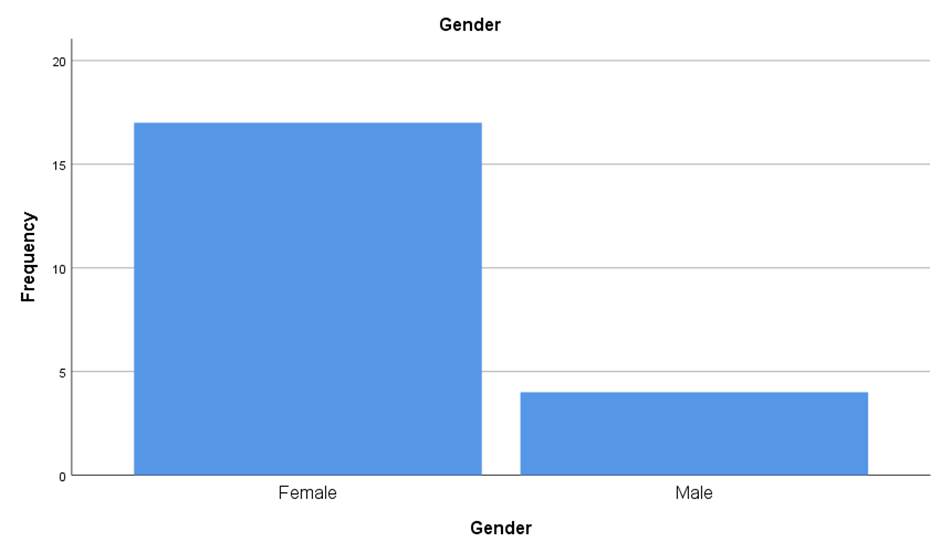
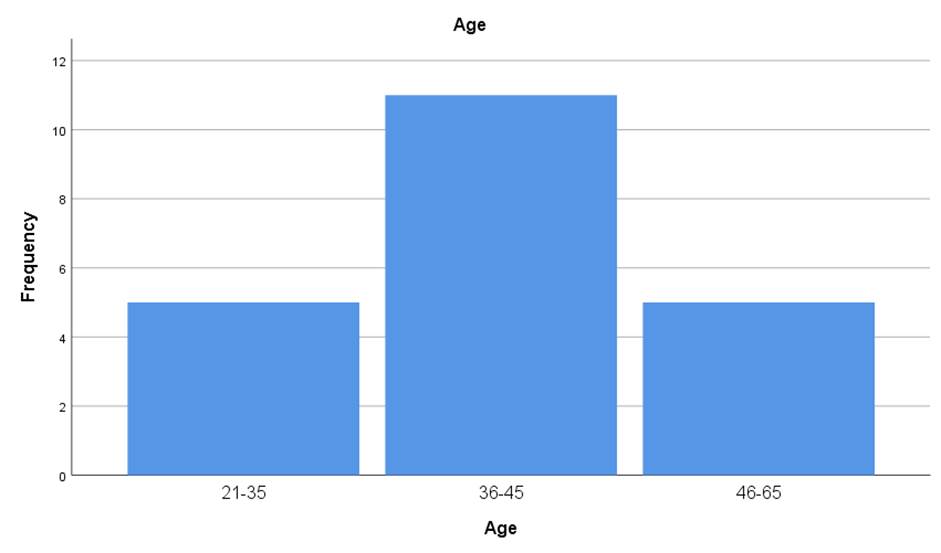
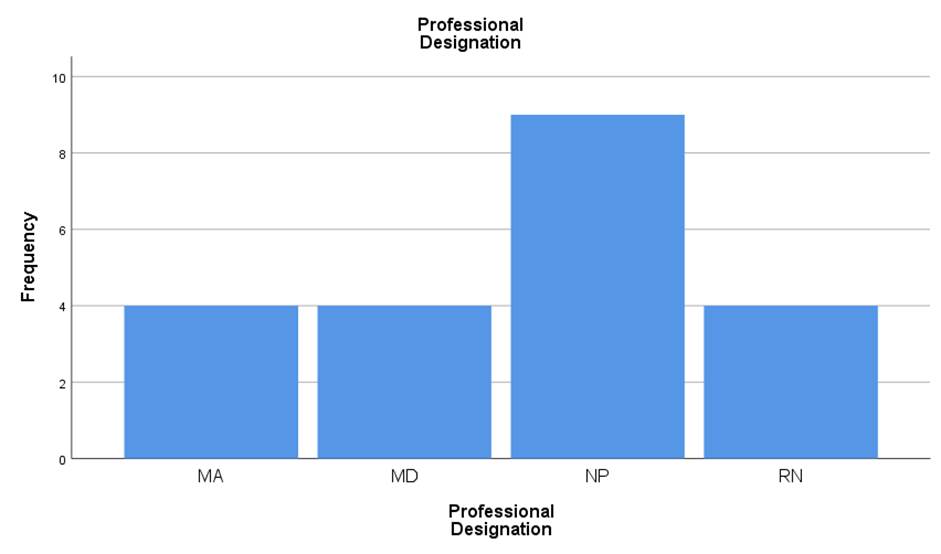
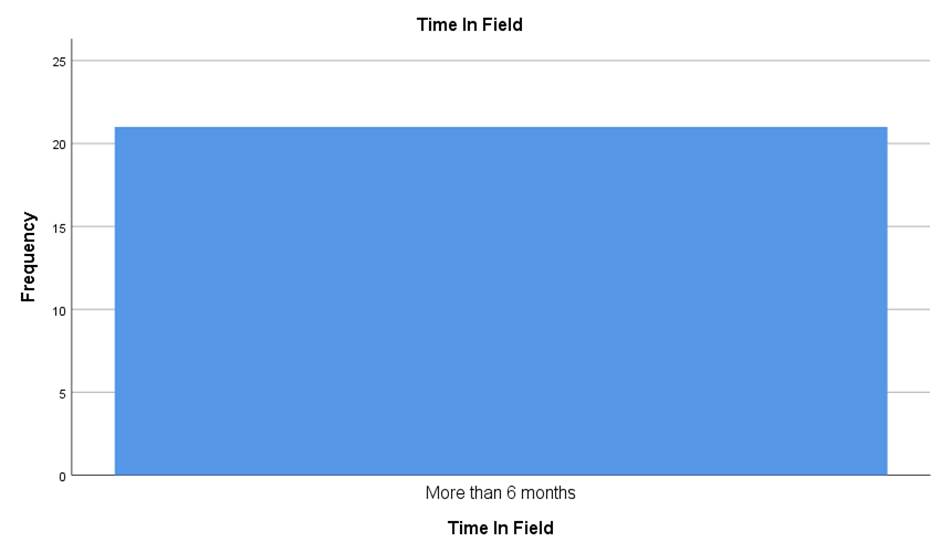
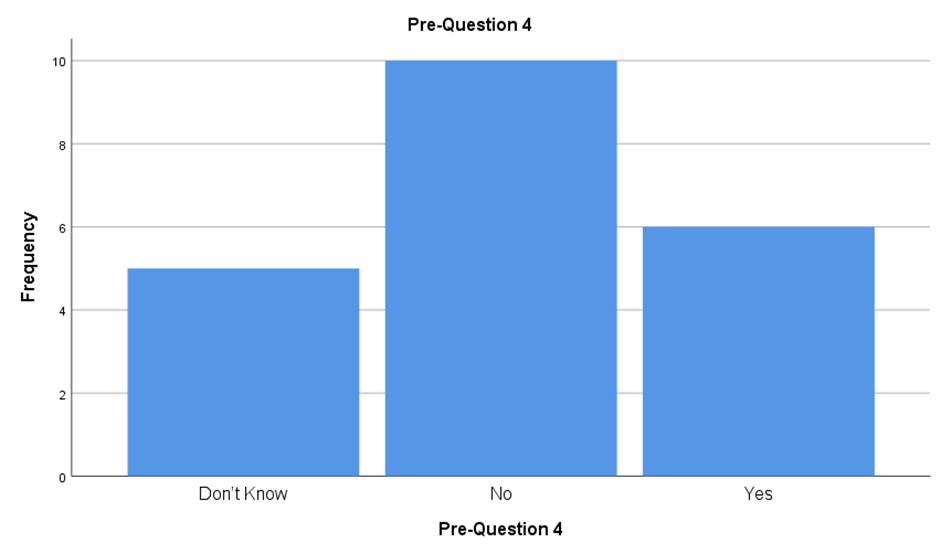
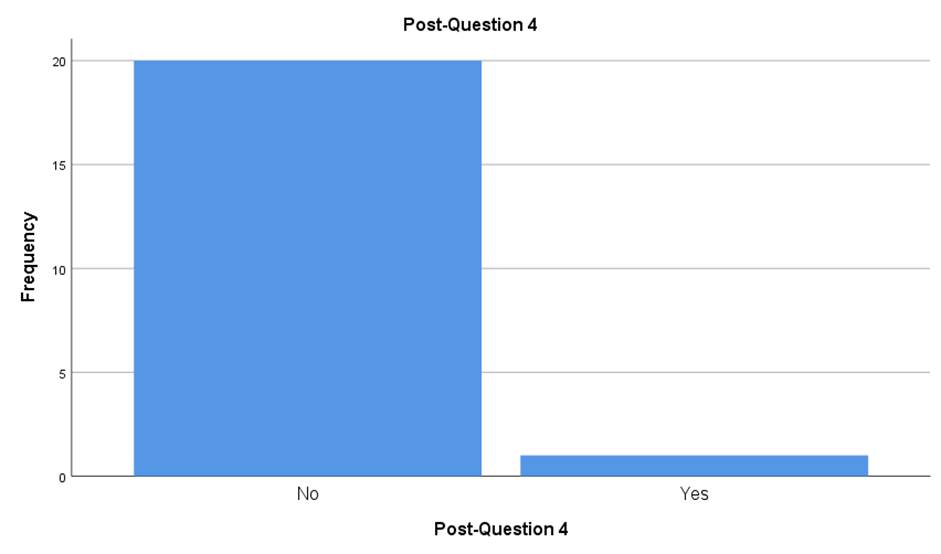
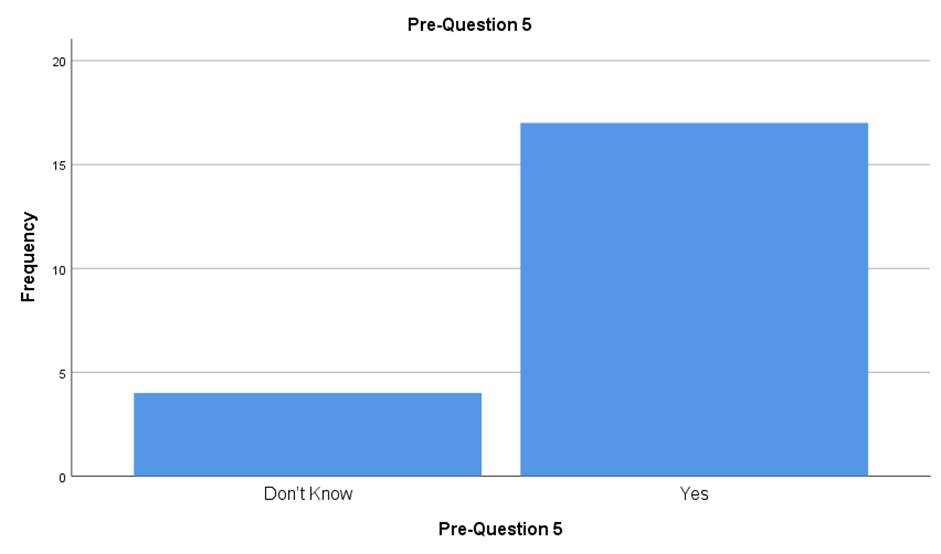
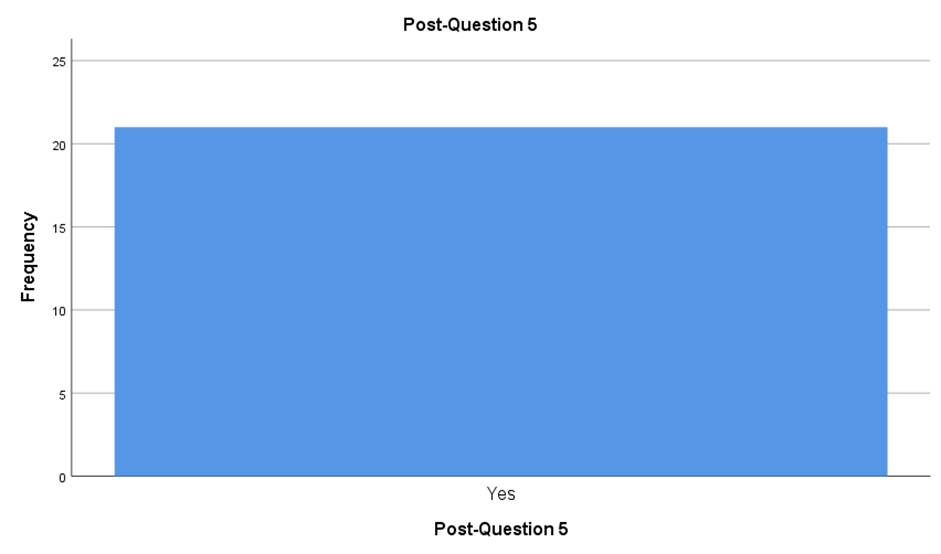
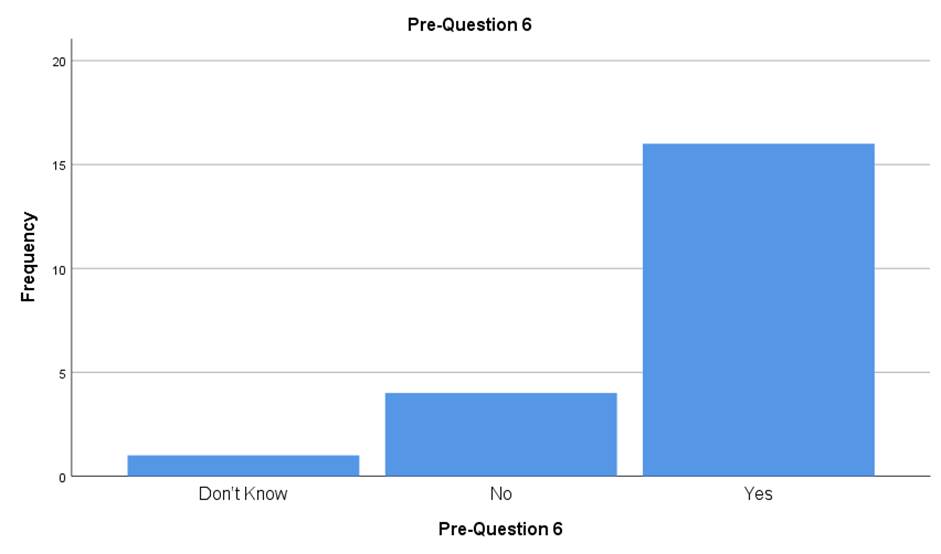
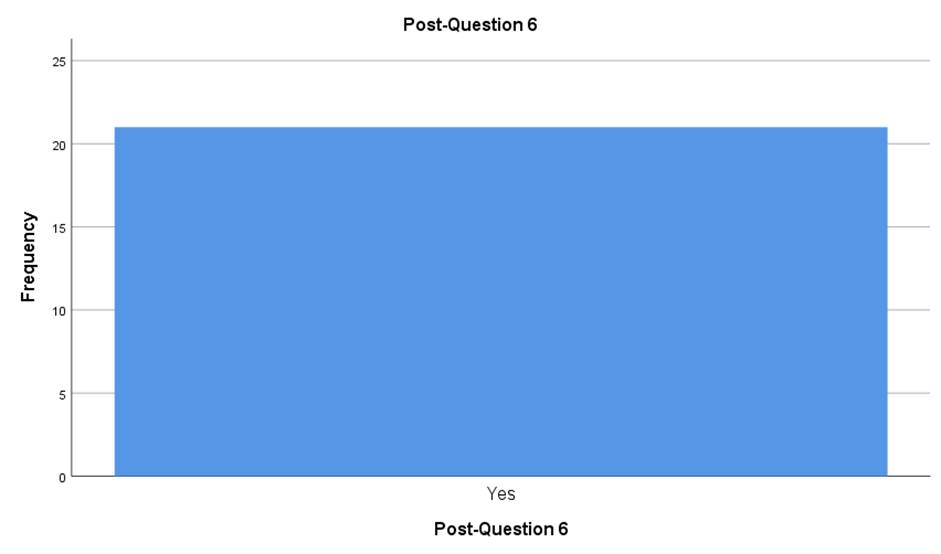
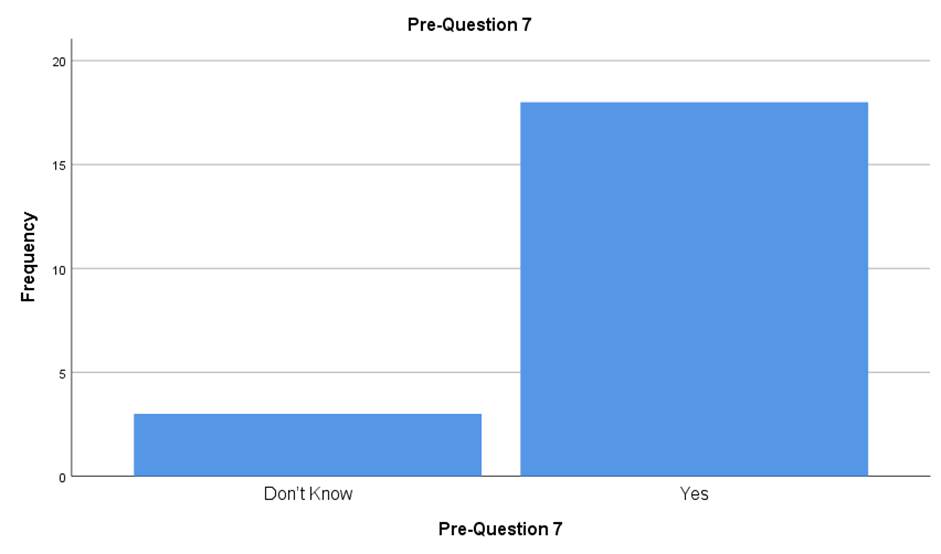
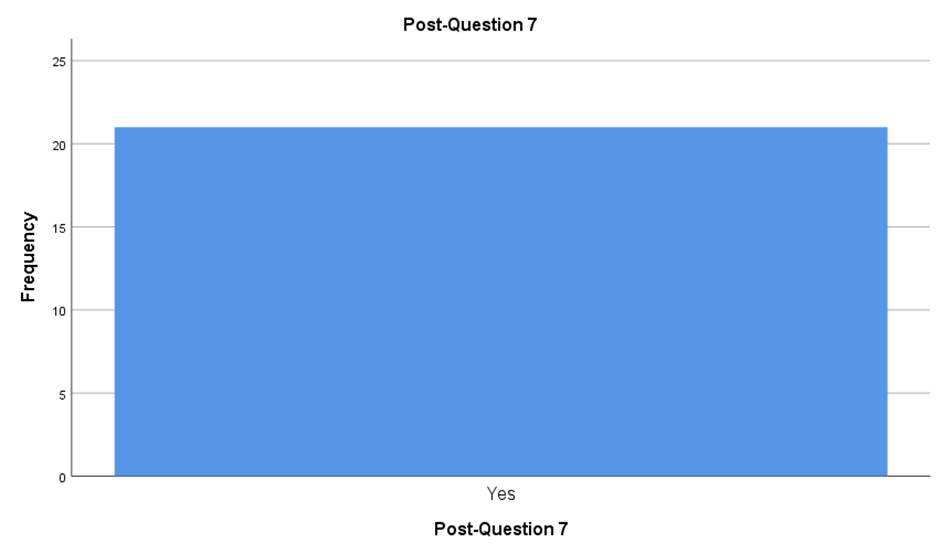
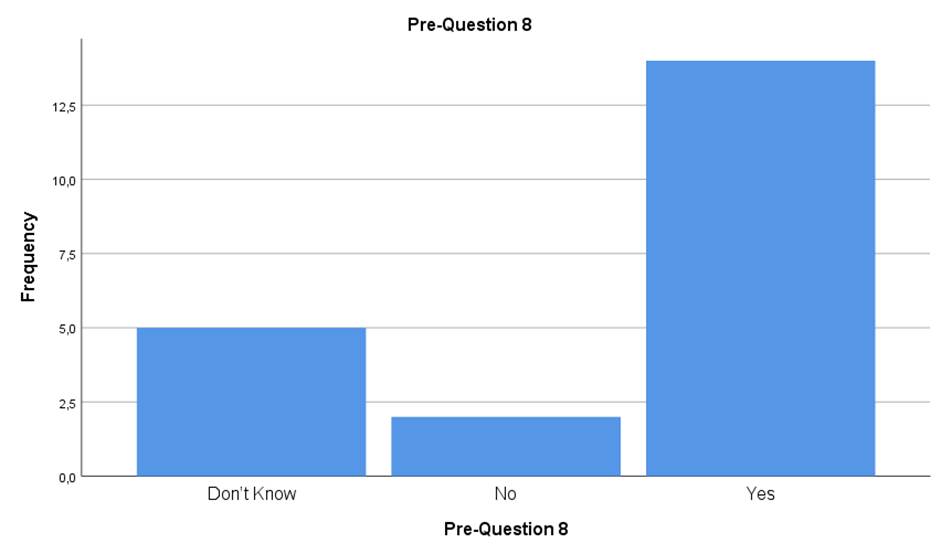
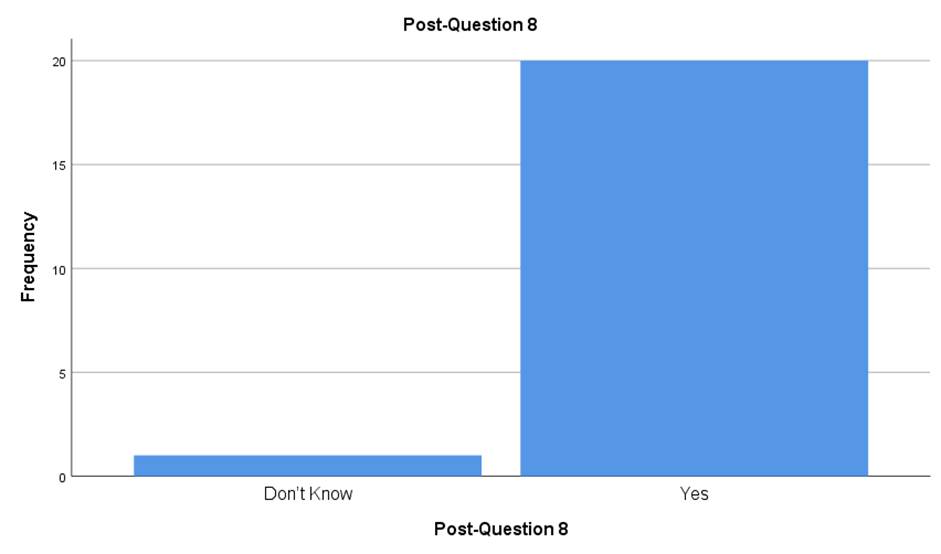
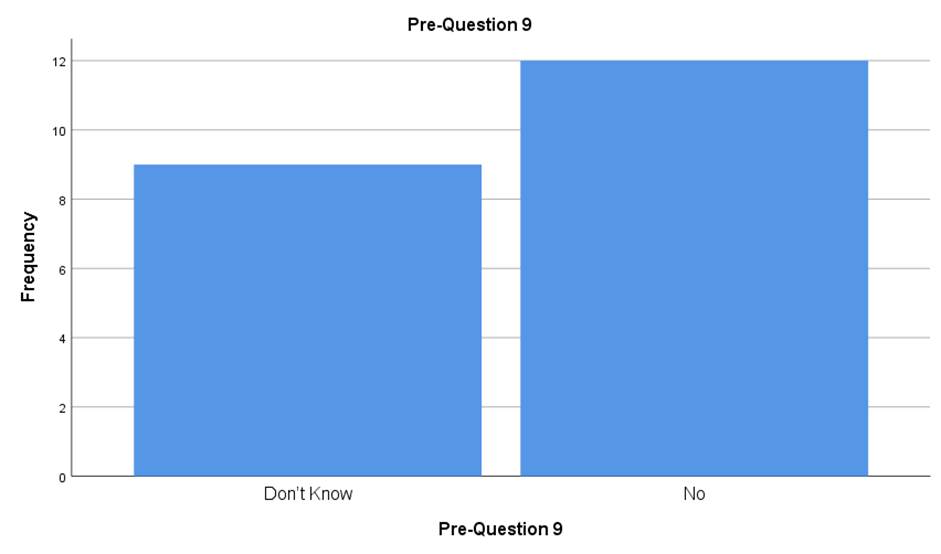
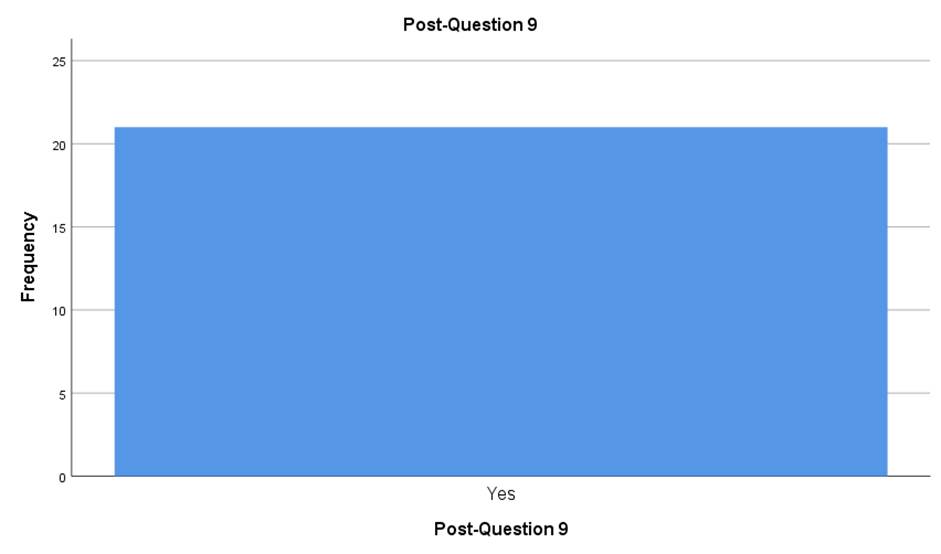
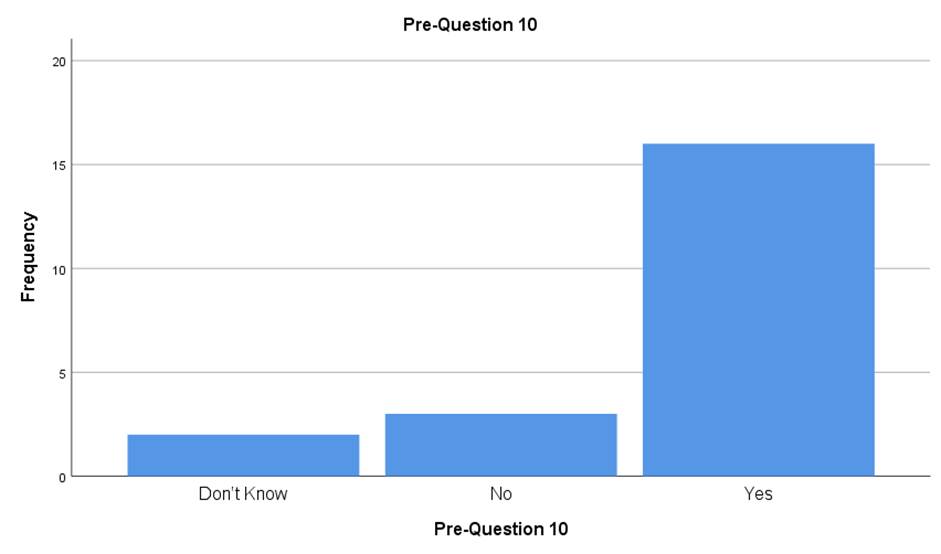
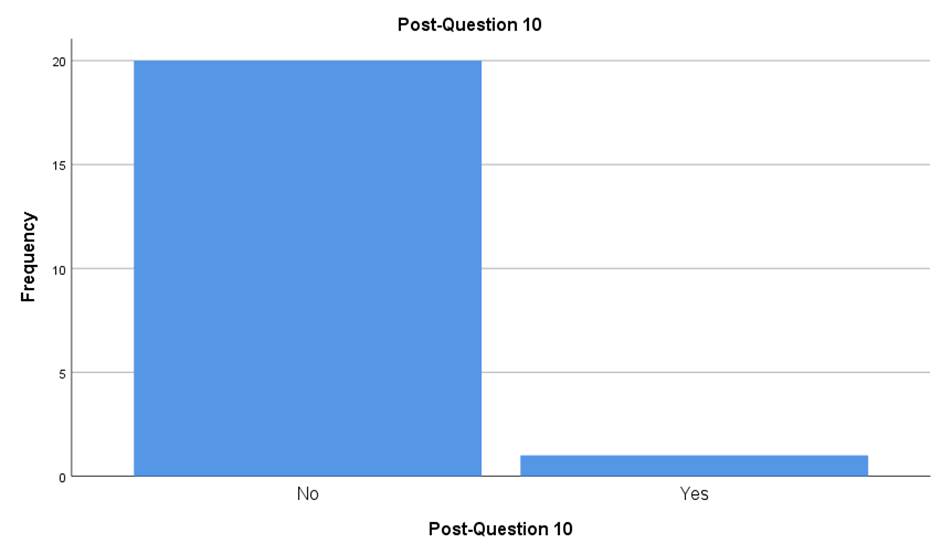
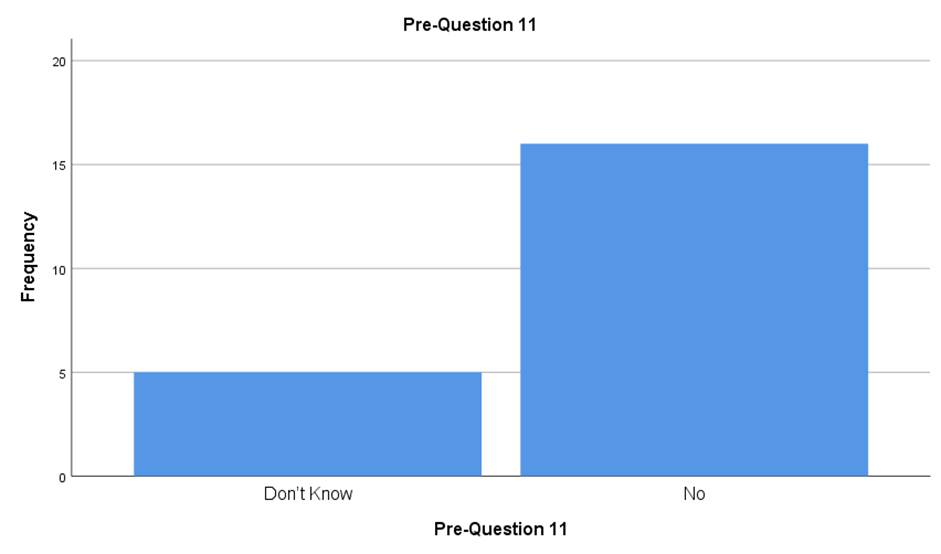
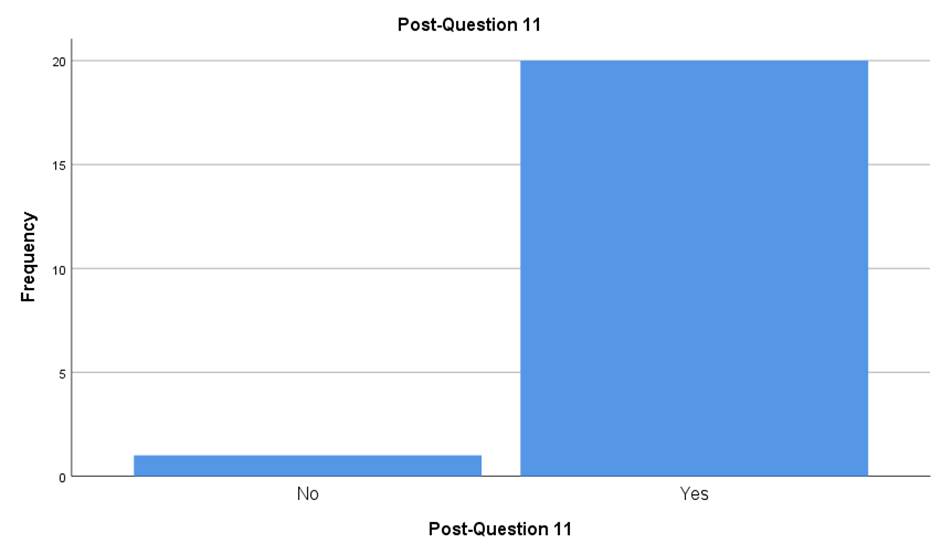
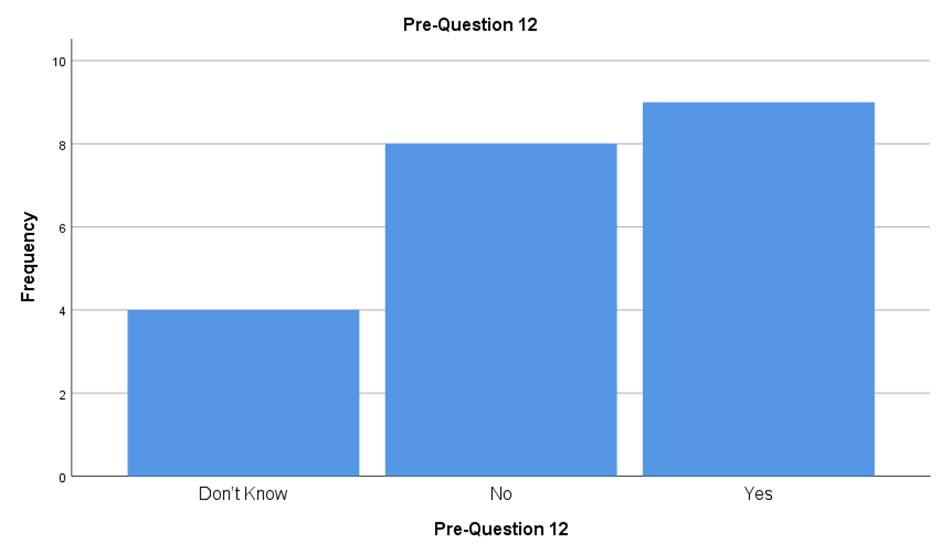
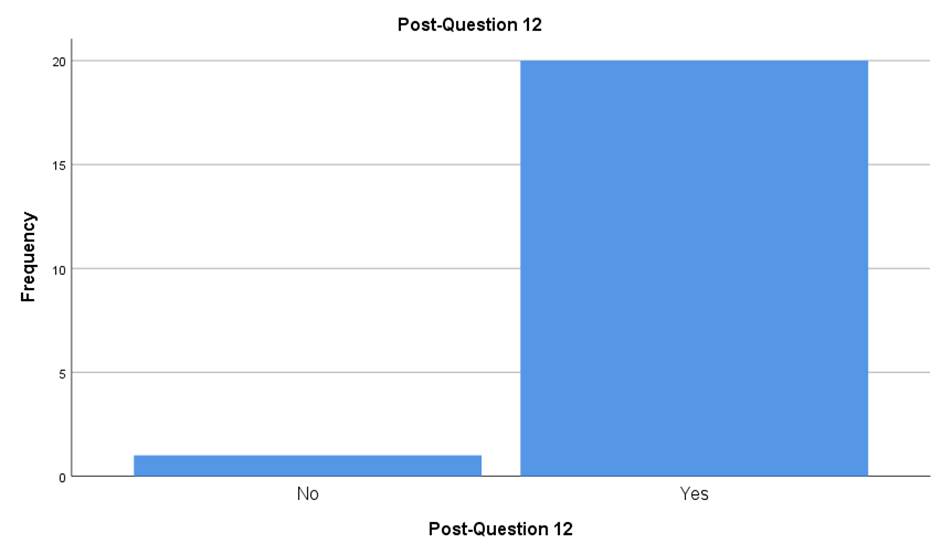
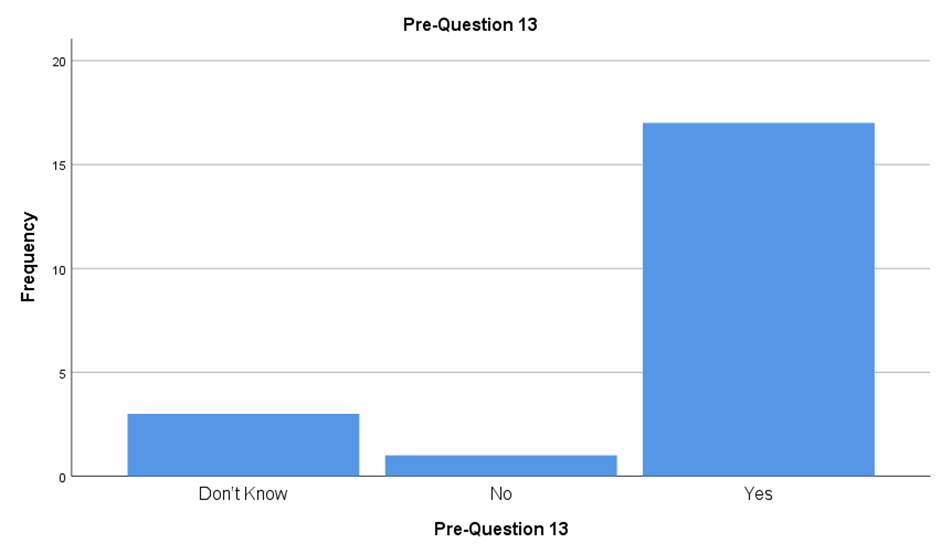
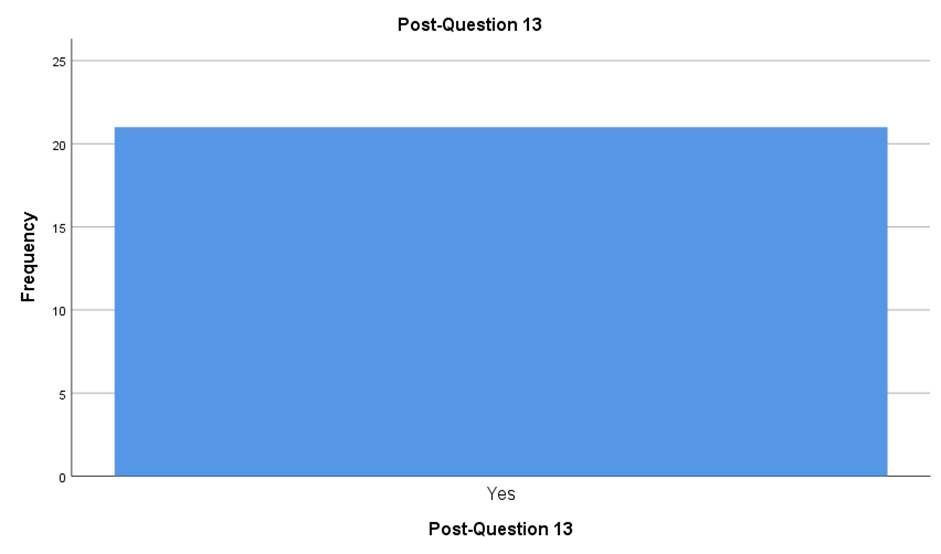
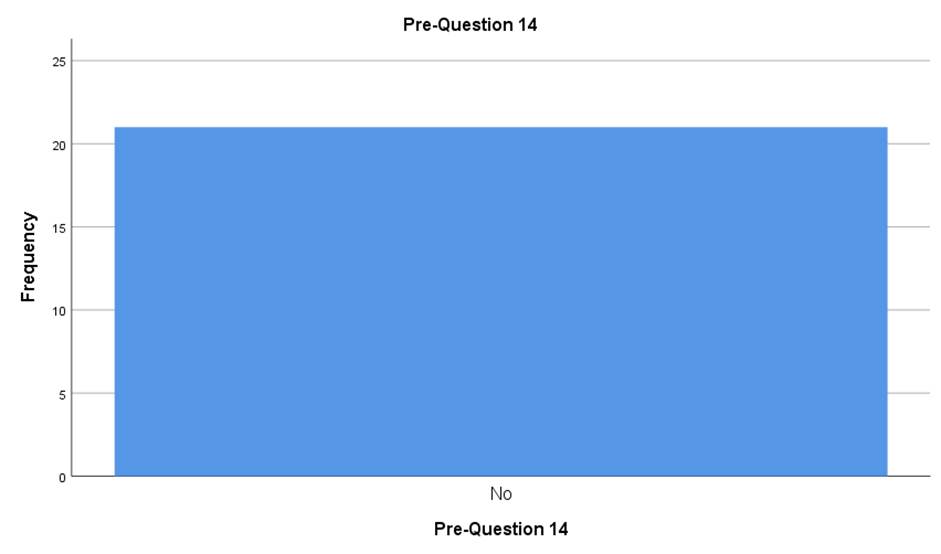
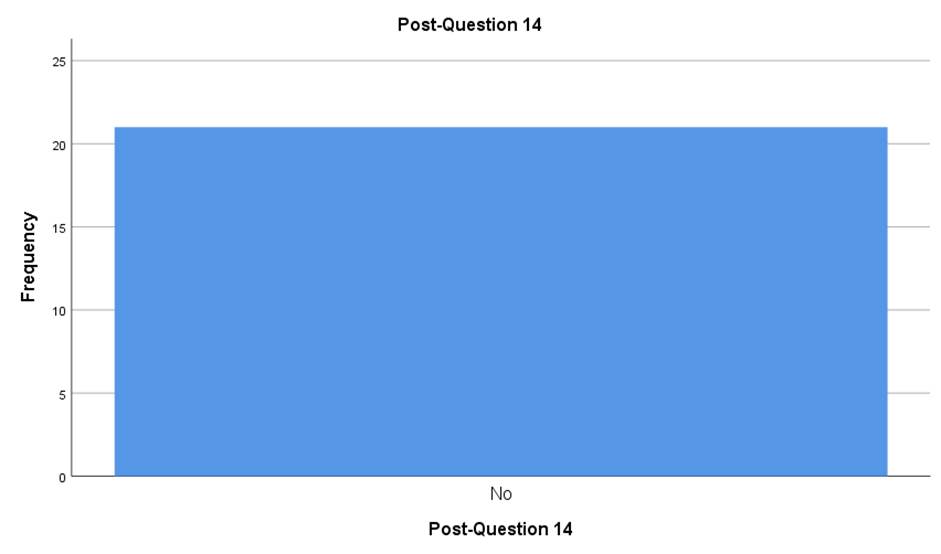
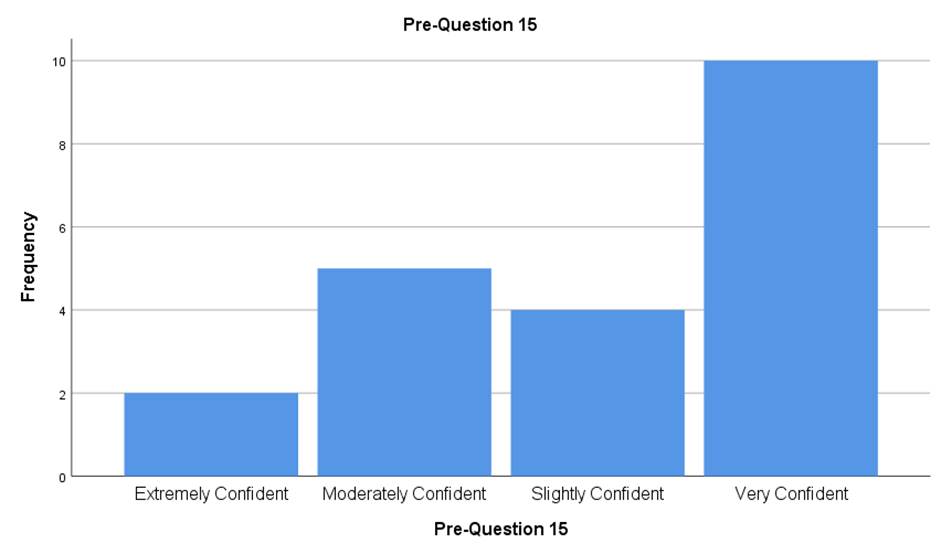
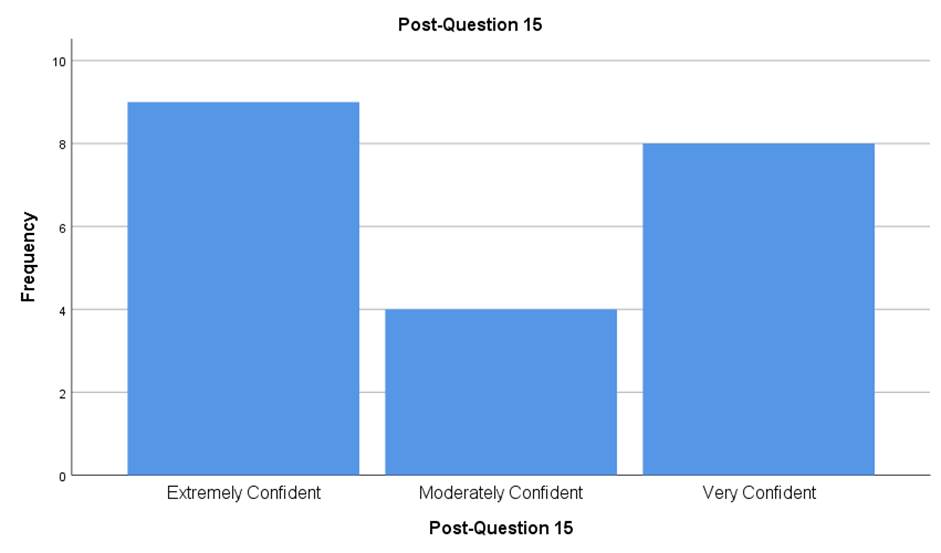
References
Alfego, D., Ennis, J., Gillespie, B., Lewis, M. J., Montgomery, E., Ferrè, S., ... & Letovsky, S. (2021). Chronic kidney disease testing among at-risk adults in the US remains low: real-world evidence from a national laboratory database. Diabetes Care, 44(9), 2025-2032. https://diabetesjournals.org/care/article/44/9/2025/138877
Anderson, A. H., Xie, D., Wang, X., Baudier, R. L., Orlandi, P., Appel, L. J., ... & Townsend, R. R. (2021). Novel risk factors for progression of diabetic and nondiabetic CKD: findings from the chronic renal insufficiency cohort (CRIC) study. American Journal of Kidney Diseases, 77(1), 56-73. https://www.sciencedirect.com/science/article/pii/S0272638620309252
Baumgart, A., Craig, J. C., & Tong, A. (2021). Qualitative research in CKD: how to appraise and interpret the evidence. American journal of kidney diseases, 77(4), 538-541. https://www.ajkd.org/article/S0272-6386(21)00008-1/fulltext
Bello, A. K., & Johnson, D. W. (2022). Educating primary healthcare providers about kidney disease. Nature Reviews Nephrology, 18(3), 133–134. https://www.nature.com/articles/s41581-021-00527-y
Benner, P. (2021). Credentials and background of the philosopher. Nursing Theorists and Their Work E-Book: Nursing Theorists and Their Work E-Book, p. 101.
Benner, P. (1984). From novice to expert. Menlo Park, 84(1480), 10-1097.
Brykczynski, K. A. (2017). Caring, Clinical Wisdom, and Ethics in Nursing Practice. In M. R. Alligood (Ed.), Nursing theorists and their work (8 ed., pp. 120-146). United States of America: Elsevier Health Sciences.
Charles, C., & Ferris, A. H. (2020). Chronic kidney disease. Primary Care: Clinics in Office Practice, 47(4), 585-595.
CDC. (2024, June 6). Chronic Kidney Disease Basics. Chronic Kidney Disease. https://www.cdc.gov/kidney-disease/about/index.html
Centers for Disease Control and Prevention. (2023). Chronic kidney disease in the United States, 2023. Atlanta, GA: US Department of Health and Human Services, Centers for Disease Control and Prevention; 2023. https://www.cdc.gov/kidney-disease/php/data-research/index.html
Chen, T. K., Sperati, C. J., Thavarajah, S., & Grams, M. E. (2021). Reducing kidney function decline in patients with CKD: core curriculum 2021. American Journal of Kidney Diseases, 77(6), 969-983. https://www.sciencedirect.com/science/article/pii/S0272638621004716
Chiu, P., Cummings, G. G., Thorne, S., & Schick-Makaroff, K. (2021). Policy advocacy and nursing organizations: A scoping review. Policy, Politics & Nursing Practice, 22(4), 271–291. https://doi.org/10.1177/15271544211050611
Chu, C. D., Powe, N. R., McCulloch, C. E., Crews, D. C., Han, Y., Bragg-Gresham, J. L., ... & Saydah, S. (2021). Trends in chronic kidney disease care in the US by race and ethnicity, 2012-2019. JAMA network open, 4(9), e2127014-e2127014. https://jamanetwork.com/journals/jamanetworkopen/article-abstract/2784527
Chu, C. D., Chen, M. H., McCulloch, C. E., Powe, N. R., Estrella, M. M., Shlipak, M. G., & Tuot, D. S. (2021). Patient awareness of CKD: a systematic review and meta-analysis of patient-oriented questions and study setting. Kidney medicine, 3(4), 576–585. https://www.sciencedirect.com/science/article/pii/S2590059521001047
Chu, C. D., McCulloch, C. E., Banerjee, T., Pavkov, M. E., Burrows, N. R., Gillespie, B. W., & Waller, L. (2020). CKD awareness among US adults by future risk of kidney failure. American Journal of Kidney Diseases, 76(2), 174–183. https://www.sciencedirect.com/science/article/abs/pii/S0272638620305321
Cockwell, P., & Fisher, L. A. (2020). The global burden of chronic kidney disease. The Lancet, 395(10225), 662–664. https://www.thelancet.com/journals/lancet/article/PIIS0140-6736(19)32977-0/fulltext
Colombijn, J. M., Idema, D. L., van der Braak, K., Spijker, R., Meijvis, S. C., Bots, M. L., & Vernooij, R. W. (2022). Evidence for pharmacological interventions to reduce cardiovascular risk for patients with chronic kidney disease: a study protocol of an evidence map. Systematic Reviews, 11(1), 238. https://link.springer.com/article/10.1186/s13643-022-02108-x
DeFronzo, R. A., & Bakris, G. L. (2022). Modifying chronic kidney disease progression with the mineralocorticoid receptor antagonist finerenone in patients with type 2 diabetes. Diabetes, Obesity and Metabolism, 24(7), 1197-1205. https://dompubs.onlinelibrary.wiley.com/doi/full/10.1111/dom.14696
Douglas, M. M. (2018). Integrating culturally competent strategies into health care practice. In M. M. Douglas, D. Pacquiao & L. Purnell (Eds.), Global applications of culturally competent healthcare: guidelines for practice (pp. 169-186): Springer.
D’Souza, P. J. J., George, L. S., Paramasivam, G., Devasia, T., George, A., Nayak, B. S., & Kusumavathi, P. (2024). Knowledge and self-care behavior among heart failure patients in South India. Journal of Education and Health Promotion, 13(1), 384.
Eljiz, K., Greenfield, D., Hogden, A., Taylor, R., Siddiqui, N., Agaliotis, M., & Milosavljevic, M. (2020). Improving knowledge translation for increased engagement and impact in healthcare. BMJ Open Quality, 9(3), e000983. https://doi.org/10.1136/bmjoq-2020-000983
Frazier, R., Levine, S., Porteny, T., Tighiouart, H., Wong, J. B., Isakova, T., & Ladin, K. (2022). Shared decision-making among older adults with advanced CKD. American journal of kidney diseases, 80(5), 599–609. https://www.sciencedirect.com/science/article/pii/S0272638622005789
Gordon, E. J., & Lash, J. P. (2021). A timely change in CKD delivery: promoting patient education. American Journal of Kidney Diseases, 57(3), 375–377. https://www.ajkd.org/article/S0272-6386(10)01703-8/fulltext
Halle, M. P., Nelson, M., Kaze, F. F., Jean Pierre, N. M. O., Denis, T., Fouda, H., & Ashuntantang, E. G. (2020). Non-adherence to hemodialysis regimens among patients on maintenance hemodialysis in sub-Saharan Africa: an example from Cameroon. Renal Failure, 42(1), 1022–1028.
House, T. R., Wightman, A., Rosenberg, A. R., Sayre, G., Abdel-Kader, K., & Wong, S. P. (2022). Challenges to shared decision making about treatment of advanced CKD: a qualitative study of patients and clinicians. American Journal of Kidney Diseases, 79(5), 657–666. https://www.sciencedirect.com/science/article/abs/pii/S0272638621009197
Hussein, R., Everett, B., Ramjan, L. M., Hu, W., & Salamonson, Y. (2017). New graduate nurses’ experiences in a clinical specialty: a follow-up study of newcomer perceptions of transitional support. BMC nursing, 16(1), 42.
KDIGO. (2024). Clinical Practice Guideline for the Evaluation and Management of Chronic Kidney Disease. https://kdigo.org/wp-content/uploads/2024/03/KDIGO-2024-CKD-Guideline.pdf
Kiernan, E., & Wong, S. P. (2024). Challenges to Informed, Patient-Centered, and Shared Decision Making for Treatment of Kidney Failure in Older Adults. American Journal of Kidney Diseases. https://www.ajkd.org/article/S0272-6386(23)00971-X/fulltext
Koch-Weser, S., Porteny, T., Rifkin, D. E., Isakova, T., Gordon, E. J., Rossi, A., & Ladin, K. (2021). Patient education for kidney failure treatment: a mixed-methods study. American Journal of Kidney Diseases, 78(5), 690-699. https://www.sciencedirect.com/science/article/abs/pii/S0272638621005618
Kvarnström, K., Westerholm, A., Airaksinen, M., & Liira, H. (2021). Factors contributing to medication adherence in patients with a chronic condition: a scoping review of qualitative research. Pharmaceutics, 13(7), 1100.
Ladin, K., & Rossi, A. (2020). Person-centered kidney education: the path forward. Kidney Medicine, 2(5), 511–513. https://www.kidneymedicinejournal.org/article/S2590-0595(20)30178-3/fulltext
Li, H., Xue, J., Dai, W., Chen, Y., Zhou, Q., & Chen, W. (2020). Visit-to-visit blood pressure variability and risk of chronic kidney disease: a systematic review and meta-analyses. PLoS One, 15(5), e0233233. https://journals.plos.org/plosone/article?id=10.1371/journal.pone.0233233
Linden, A., Biuso, T. J., & Butterworth, S. W. (2020). Help patients with chronic kidney disease stave off dialysis: screening and timely referral are key. But this health coaching technique can make a big difference, too. Journal of Family Practice, 59(4), 212-219. https://go.gale.com/ps/i.do?id=GALE%7CA225435500&sid=googleScholar&v=2.1&it=r&linkaccess=abs&issn=00943509&p=AONE&sw=w&userGroupName=anon%7E5bd938bd&aty=open-web-entry
Mailani, F., Febriyana, I., Rahman, D., Sarfika, R., & Mulaintino, M. R. (2024). Good health literacy leads to better quality of life and medication adherence among hemodialysis patients. Jurnal NERS, 19(1), 103-111. https://doi.org/10.20473/jn.v19i1.49247
Mailani, F., Muthia, R., Huriani, E., & Sarfika, R. (2024). Health literacy among chronic kidney disease patients: disparities in information seeking, educational needs, and the role of healthcare professionals. The Qualitative Report, 29(8), 2156-2172. https://doi.org/10.46743/2160-3715/2024.6856
Mannan, A., Hasan, M. M., Akter, F., Rana, M. M., Chowdhury, N. A., Rawal, L. B., & Biswas, T. (2021). Factors associated with low adherence to medication among patients with type diabetes at different healthcare facilities in southern Bangladesh. Global health action, 14(1), 1872895.
Meijers, B., Wellekens, K., Montomoli, M., Altabas, K., Geter, J., McCarthy, K., ... & Thomas, N. (2023). Healthcare professional education in shared decision making in the context of chronic kidney disease: a scoping review. BMC nephrology, 24(1), 195. https://link.springer.com/article/10.1186/s12882-023-03229-8
Mendu, M. L., & Weiner, D. E. (2020). Health policy and kidney care in the United States: core curriculum 2020. American Journal of Kidney Diseases, 76(5), 720-730. https://www.sciencedirect.com/science/article/pii/S0272638620307824
Molnar, A. O., Bota, S., Jeyakumar, N., McArthur, E., Battistella, M., Garg, A. X., ... & Brimble, K. S. (2020). Potentially inappropriate prescribing in older adults with advanced chronic kidney disease. PLoS One, 15(8), e0237868. https://journals.plos.org/plosone/article?id=10.1371/journal.pone.0237868
Mooney, A. F., Winterbottom, A., & Bekker, H. L. (2019). The importance of expert education in enabling informed, activated patients. Kidney International, 75(10), 1116-1117. https://www.kidney-international.org/article/S0085-2538(15)53561-8/fulltext
Nilsen, P., Seing, I., Ericsson, C., Birken, S. A., & Schildmeijer, K. (2020). Characteristics of successful changes in health care organizations: an interview study with physicians, registered nurses and assistant nurses. BMC Health Services Research, 20(1), 147. https://doi.org/10.1186/s12913-020-4999-8
Oshvandi, K., Moghadam, A., Khatiban, M., Cheraghi, F., Borzu, R., & Moradi, Y. (2016). On the application of novice to expert theory in nursing; a systematic review. Journal of Chemical and Pharmaceutical Sciences, 9(4), 3014-3020
Ozdemir, N. G. (2019). The development of nurses’ individualized care perceptions and practices: Benner’s novice to expert model perspective. International Journal of Caring Sciences, 12(2), 1279-1285.
Park, J., Kim, H. J., Kim, J., Choi, Y. B., Shin, Y. S., & Lee, M. J. (2020). Predictive value of serum albumin-to-globulin ratio for incident chronic kidney disease: A 12-year community-based prospective study. PloS one, 15(9), e0238421. https://journals.plos.org/plosone/articleid=10.1371/journal.pone.0238421
Peralta, C. A., Livaudais-Toman, J., Stebbins, M., Lo, L., Robinson, A., Pathak, S., ... & Karliner, L. S. (2020). Electronic decision support for management of CKD in primary care: a pragmatic randomized trial. American Journal of Kidney Diseases, 76(5), 636-644. https://www.sciencedirect.com/science/article/pii/S027263862030754X
Rangaswami, J., Bhalla, V., De Boer, I. H., Staruschenko, A., Sharp, J. A., Singh, R. R., ... & McCullough, P. A. (2020). Cardiorenal protection with the newer antidiabetic agents in patients with diabetes and chronic kidney disease: a scientific statement from the American Heart Association. Circulation, 142( 17), e265-e286. https://www.ahajournals.org/doi/full/10.1161/CIR.0000000000000920
Rivera, E., Clark-Cutaia, M. N., Schrauben, S. J., Townsend, R. R., Lash, J. P., Hannan, M., ... & Hirschman, K. B. (2022). Treatment adherence in CKD and support from health care providers: a qualitative study. Kidney Medicine, 4(11), 100545. https://doi.org/10.1016/j.xkme.2022.100545
Saran, R., Pearson, A., Tilea, A., Shahinian, V., Bragg-Gresham, J., Heung, M., ... & Rios, F. (2021). Burden and cost of caring for US Veterans with CKD: initial findings from the VA Renal Information System (VA-REINS). American Journal of Kidney Diseases, 77(3), 397-405. https://www.sciencedirect.com/science/article/abs/pii/S0272638620309276
Schrauben, S. J., Appel, L., Rivera, E., Lora, C. M., Lash, J. P., Chen, J., ... & Unruh, M. L. (2021). Mobile health (mHealth) technology: assessment of availability, acceptability, and use in CKD. American Journal of Kidney Diseases, 77(6), 941-950. https://www.sciencedirect.com/science/article/abs/pii/S0272638620311392
Schrauben, S. J., Chen, H. Y., Lin, E., Jepson, C., Yang, W., Scialla, J. J., ... & CRIC Study Investigators. (2020). Hospitalizations among adults with chronic kidney disease in the United States: a cohort study. PLoS medicine, 17(12), e1003470. https://journals.plos.org/plosmedicine/article?id=10.1371/journal.pmed.1003470
Seng, J. J. B., Tan, J. Y., Yeam, C. T., Htay, H., & Foo, W. Y. M. (2020). Factors affecting medication adherence among pre-dialysis chronic kidney disease patients: a systematic review and meta-analysis of the literature. International urology and nephrology, 52(5), 903-916.
Shen, H., van der Kleij, R., van der Boog, P. J., Wang, W., Song, X., Li, Z., ... & Chavannes, N. (2022). Digital tools/eHealth to support CKD self-management: A qualitative study of perceptions, attitudes and needs of patients and health care professionals in China. International Journal of Medical Informatics, 165, 104811. https://www.sciencedirect.com/science/article/pii/S1386505622001253
Stempniewicz, N., Vassalotti, J. A., Cuddeback, J. K., Ciemins, E., Storfer-Isser, A., Sang, Y., ... & Coresh, J. (2021). Chronic kidney disease testing among primary care patients with type 2 diabetes across 24 US health care organizations. Diabetes care, 44(9), 2000-2009. https://diabetesjournals.org/care/article/44/9/2000/138842/Chronic-Kidney-Disease-Testing-Among-Primary-Care
Tesfaye, W., Parrish, N., Sud, K., Grandinetti, A., & Castelino, R. (2024). Medication adherence among patients with kidney disease: An umbrella review. Advances in Kidney Disease and Health, 31(1), 68-83. https://doi.org/10.1053/j.akdh.2023.08.003
Tesfaye, W. H., Erku, D., Mekonnen, A., Tefera, Y. G., Castelino, R., Sud, K., ... & Obamiro, K. (2021). Medication non-adherence in chronic kidney disease: a mixed-methods review and synthesis using the theoretical domains framework and the behavioural change wheel. Journal of Nephrology, 1-35.
Thomas, C. M., & Kellgren, M. (2017). Benner’s novice to expert model: An application for simulation facilitators. Nursing Science Quarterly, 30(3), 227-234.
Torres-Robles, A., Benrimoj, S. I., Gastelurrutia, M. A., Martinez-Martinez, F., Peiro, T., Perez-Escamilla, B., Rogers, K., Valverde-Merino, I., Varas-Doval, R., & Garcia-Cardenas, V. (2022). Effectiveness of a medication adherence management intervention in a community pharmacy setting: A cluster randomised controlled trial. BMJ Quality & Safety, 31(2), 105–115. https://doi.org/10.1136/bmjqs-2020-011671
Tzeggai, J., Jones, K., Puri, T., & Saunders, M. (2020). Improving CKD patient knowledge and patient-physician communication: a pilot study of a CKD report card. Kidney Medicine, 2(3), 369-372. https://www.kidneymedicinejournal.org/article/S2590-0595(20)30064-9/fulltext
van Dulmen, S., Roodbeen, R., Schulze, L., Prantl, K., Rookmaaker, M., van Jaarsveld, B., ... & Abrahams, A. (2022). Practices and perspectives of patients and healthcare professionals on shared decision-making in nephrology. BMC nephrology, 23(1), 258. https://link.springer.com/article/10.1186/s12882-022-02887-4
Vart, P., Powe, N. R., McCulloch, C. E., Saran, R., Gillespie, B. W., Saydah, S., & Crews, D. C. (2020). National trends in the prevalence of chronic kidney disease among racial/ethnic and socioeconomic status groups, 1988-2016. JAMA network open, 3(7), e207932-e207932.
https://jamanetwork.com/journals/jamanetworkopen/article-abstract/2768339
Walther, C. P., Winkelmayer, W. C., & Navaneethan, S. D. (2022). Updated US prevalence estimates for chronic kidney disease stage and complications using the new race-free equation to estimate glomerular filtration rate. JAMA Network Open, 5(2), e220460-e220460.
https://jamanetwork.com/journals/jamanetworkopen/article-abstract/2789063
Wei, C. J., Shih, C. L., Hsu, Y. J., Chen, Y. C., Yeh, J. Z., Shih, J. H., & Chiu, C. H. (2021). Development and application of a chronic kidney disease-specific health literacy, knowledge and disease awareness assessment tool for patients with chronic kidney disease in Taiwan. BMJ open, 11(10), e052597. https://scholar.google.com/scholar?output=instlink&q=info:1Nn436iNT6gJ:scholar.google.com/&hl=en&as_sdt=0,5&scillfp=11054652876099871505&oi=lle
Whelton, P. K., Carey, R. M., Mancia, G., Kreutz, R., Bundy, J. D., & Williams, B. (2022). Harmonization of the American College of Cardiology/American Heart Association and European Society of Cardiology/European Society of Hypertension blood pressure/hypertension guidelines: comparisons, reflections, and recommendations. European Heart Journal, 43(35), 3302-3311. https://academic.oup.com/eurheartj/article/43/35/3302/6661233
Zhan, M., Doerfler, R. M., Xie, D., Chen, J., Chen, H. Y., Diamantidis, C. J., ... & Townsend, R. R. (2020). Association of Opioids and Nonsteroidal Anti-inflammatory Drugs With Outcomes in CKD: áFindings From the CRIC (Chronic Renal Insufficiency Cohort) Study. American Journal of Kidney Diseases, 76(2), 184-193. https://www.sciencedirect.com/science/article/pii/S0272638620300421
Zhao, J. Z., Weinhandl, E. D., Carlson, A. M., & Peter, W. L. S. (2023). Disparities in SGLT2 inhibitor or glucagon-like peptide 1 receptor agonist initiation among Medicare-insured adults with CKD in the United States. Kidney Medicine, 5(1), 100564. https://www.sciencedirect.com/science/article/pii/S2590059522001960
Zoungas, S., & de Boer, I. H. (2021). SGLT2 inhibitors in diabetic kidney disease. Clinical Journal of the American Society of Nephrology, 16(4), 631-633. https://journals.lww.com/cjasn/fulltext/2021/04000/sglt2_inhibitors_in_diabetic_kidney_disease.20.aspx
Appendix
Appendix 1: Informed Concern
AGM UNIVERSITY
South Florida Campus
Nursing Department DNP Program
Informed consent for a study with minimum risk
Use of structured educational programs directed to healthcare providers to improve patients’ adherence to CKD medications
Description of the study and the role of your participation
Guillermo Suarez is inviting you to participate in a research study. Guillermo Suarez, APRN, FNP-BC, Principal Investigator, is a student at Ana G. Mendez University, and Geisy M. Vilabrille, DNP, is a professor at the AGM University, South Florida Campus. The purpose of this research is to use structured educational programs directed to healthcare providers to improve patients' adherence to CKD medications.
This research project will explore the healthcare providers' involvement in the identification of patients who will benefit from CKD medications, promoting patient engagement in the decision-making process, and addressing CKD medication adherence.
Your participation in this research will consist of a pre-assessment via test, followed by an educational activity, and a post-test assessment to measure the impact.
It will take you between 50 to 60 minutes to complete this activity which includes a pre-test, an educational activity, and a post-test.
Risks and Discomforts
At the moment, we do not know of possible risks or discomforts that you may suffer during the process, other than those experienced in daily life. These could be tiredness and boringness. However, you should not worry, because in case of an unexpected event we have an action plan to meet your needs. These include offering rest periods after each activity to ensure your comfort and well-being.
Potential benefits
The benefits of your participation in this investigation include gaining knowledge about CKD medications and how to properly communicate the importance of compliance with your patients with CKD. The society at large will benefit because improving medication adherence among CKD patients is directly linked to better patient outcomes, which is a primary goal for healthcare providers
Incentives
There are no incentives for participating in this study.
Protection of Privacy, Confidentiality, and Decommission Process
All information about your identity will be handled privately and confidentially and will always be protected using an alpha-numeric code, and all documentation will be placed in a sealed envelope. Under no circumstances will the participant's information be shared with third parties. The collected data will be stored in a private, secure, and locked cabinet located in the private office at the PI's private residence. Any document collected or electronic devices will be stored in the PI's home office in a locked cabinet for five (5) years. All data will be under the tutelage of Guillermo Suarez. Only the PI will have access to the data. After five (5) years, all related documentation will be destroyed by Guillermo Suarez using a paper shredder. All electronic storage devices will be destroyed using a blunt object.
Decision about your participation in this study
Your participation in this study is voluntary. You have the right to decide whether to participate or not. If you decide to participate in this study, you have the right to withdraw at any time without penalty or retaliation.
Contact information
If you have any questions or concerns regarding this research study or if any situation arises during the study period, please contact Guillermo Suarez, at [email protected] If you have questions about your rights as a research subject or need any additional information or have questions, you can contact your IRB Coordinator at (407) 563-6501 Ext. 5520 or at [email protected].
You should contact (407) 563- 6502 Ext. 5575 or write to the address below to report a case of non-compliance in the investigation.
AGM University
Dean of Academic Affairs
5575 S Semoran Blvd. Suite 502
Orlando, FL 32822
Tel. (407) 563-6501 Ext. 5575; Fax (407) 277-8706
Appendix 2: Pre-test and Post-test
PRETEST-POSTTEST
Use of structured educational programs directed to healthcare providers to improve patients’ adherence to CKD medications.
Introduction:
This questionnaire is an essential part of a quality improvement project aiming to
increase the patient's adherence to CKD medications through an educational program
targeting healthcare providers
Please, answer to the best of your knowledge. Your response will help to understand gaps
in knowledge and room for improvement. The questions are structured to assess your
understanding regarding CKD management, guidelines, assessment of the patient's adherence to medication, patient education, and management. The test was created by the Principal Investigator based on information from "The Centers for Disease Control and Prevention. Chronic Kidney Disease in the United States, 2023. Atlanta, GA: US Department of Health and Human Services, Centers for Disease Control and Prevention. 2023. "https://www.cdc.gov/kidney-disease/media/pdfs/CKD-Factsheet-H.pdf
Participant Number: ___________
Pre-Test _______ Post-Test _______
1- Gender:
a) Female ______
b) Male ______
2- Age:
a) 21- 35 ____
b) 36- 45 ____
c) 46-65 ____
3- Professional Designation
a) MD _____
b) NP _____
c) PA _____
e) RN _____
f) LPN _____
g) MA_____
4. Stage 4 of Chronic Kidney Disease (CKD) requires the most aggressive intervention to delay progression
a) Yes ____
b) No ____
c) Don’t Know ______
5. The most common class of medications used to slow the progression of CKD is the ACE Inhibitors. (ACEIs)
a. Yes ____
b. No _____
c. Don’t Know ____
6. Maintaining optimal blood pressure is one of the most important factors in preventing the progression of CKD.
a. Yes ___
b. No ____
c. Don’t Know ____
7. Estimated Glomerular Filtration Rate (eGFR) lab test is typically used to assess kidney function in patients with CKD
a. Yes ___
b. No ___
c. Don’t Know ___
8. High-protein diet is NOT typically recommended for patients with CKD to manage their condition
a. Yes ____
b. No ____
c. Don’t Know ____
9. On average, 50% of patients with CKD do not adhere to their prescribed medication regimen.
a. Yes ____
b. No ____
c. Don’t Know _____
10. Patient adherence to CKD medications is mostly affected by financial barriers.
a. Yes ___
b. No ____
c. Don’t know ____
11. Forgetfulness is the most common reason patients with CKD stop taking their medications.
a. Yes ___
b. No ___
c. Don’t know ____
12. Simplifying the medication regimen is considered the most effective strategy for improving medication adherence in patients with CKD.
a. Yes ____
b. No ____
c. Don’t know ____
13. Using visual aids and simplified language is the most effective in educating CKD patients about medication adherence
a. Yes ____
b. No ____
c. Don’t know ____
14. Healthcare providers play a minimal role in influencing patient adherence to CKD medications.
a. Yes ____
b. No ____
c. Don’t know ____
15. On a scale of 1 to 5, how confident are you in your ability to educate patients on the importance of adhering to their CKD medications?
a. 1: Not confident _____
b. 2: Slightly confident _____
c. 3: Moderately confident _____
d. 4: Very confident _____
e. 5: Extremely confident _____
The test was created by the Principal Investigator based on information from "The Centers for Disease Control and Prevention. Chronic Kidney Disease in the United States, 2023. Atlanta, GA: US Department of Health and Human Services, Centers for Disease Control and Prevention. 2023."https://www.cdc.gov/kidney-disease/media/pdfs/CKD-Factsheet-H.pdf
Appendix 3: Support Letter
